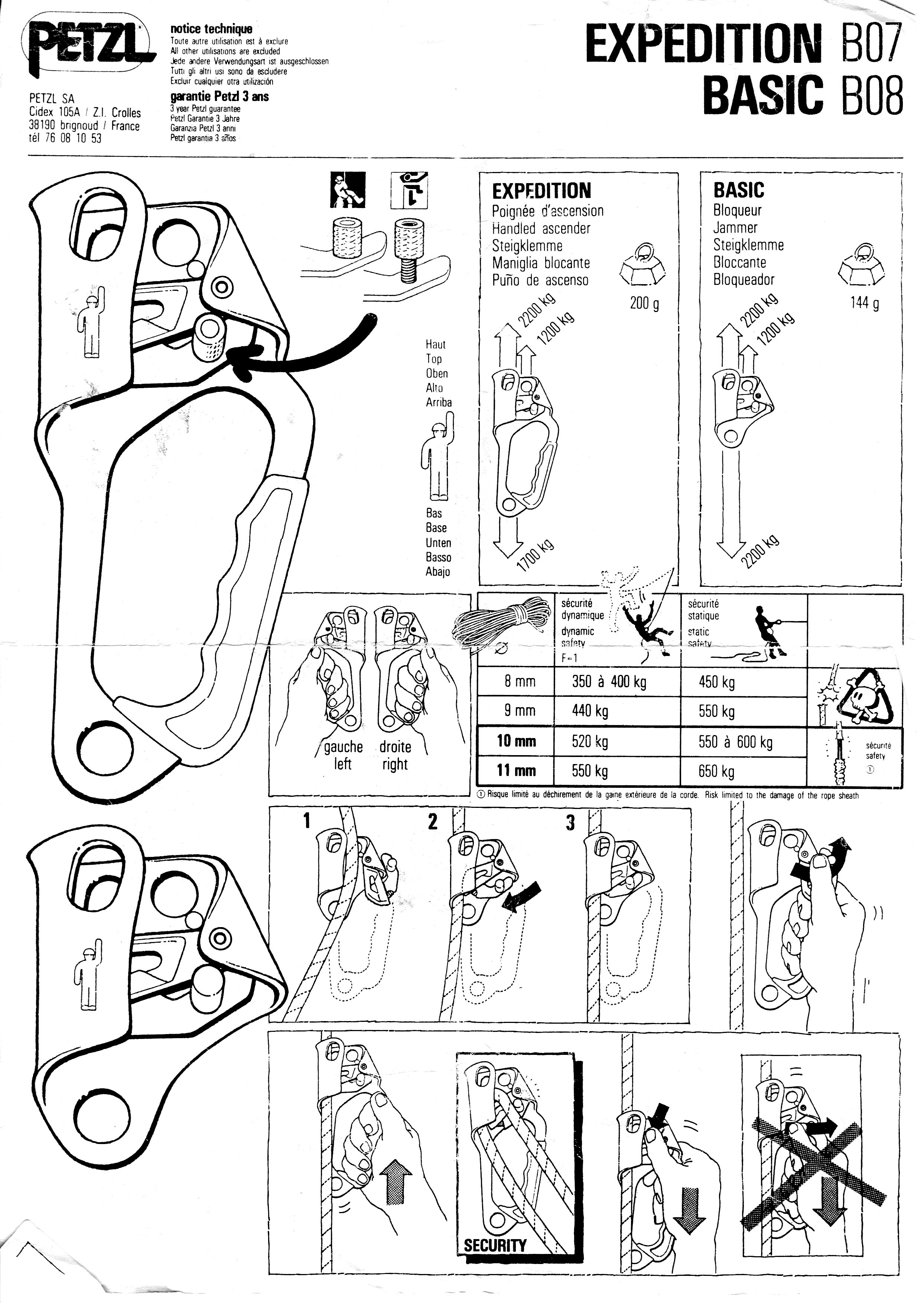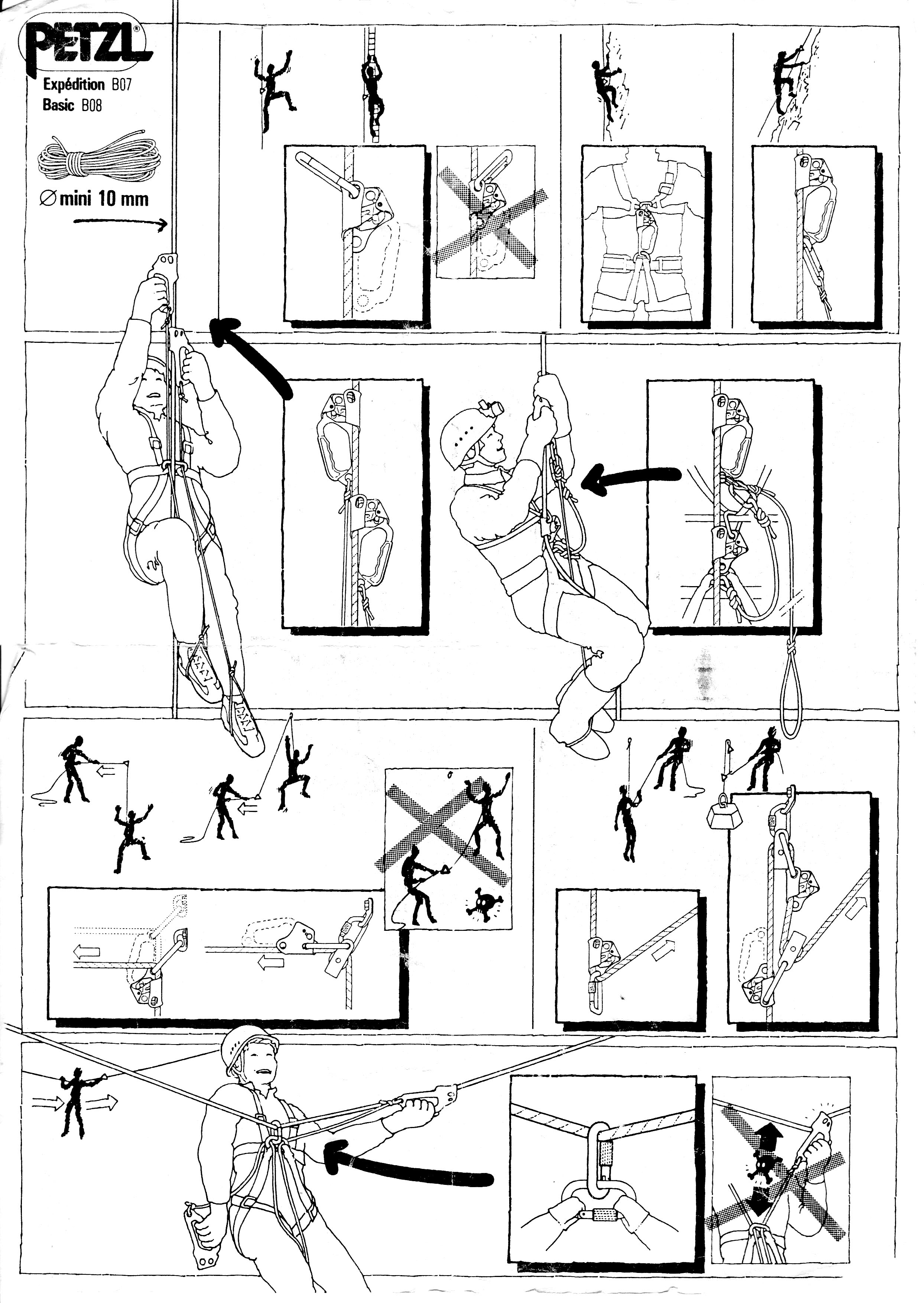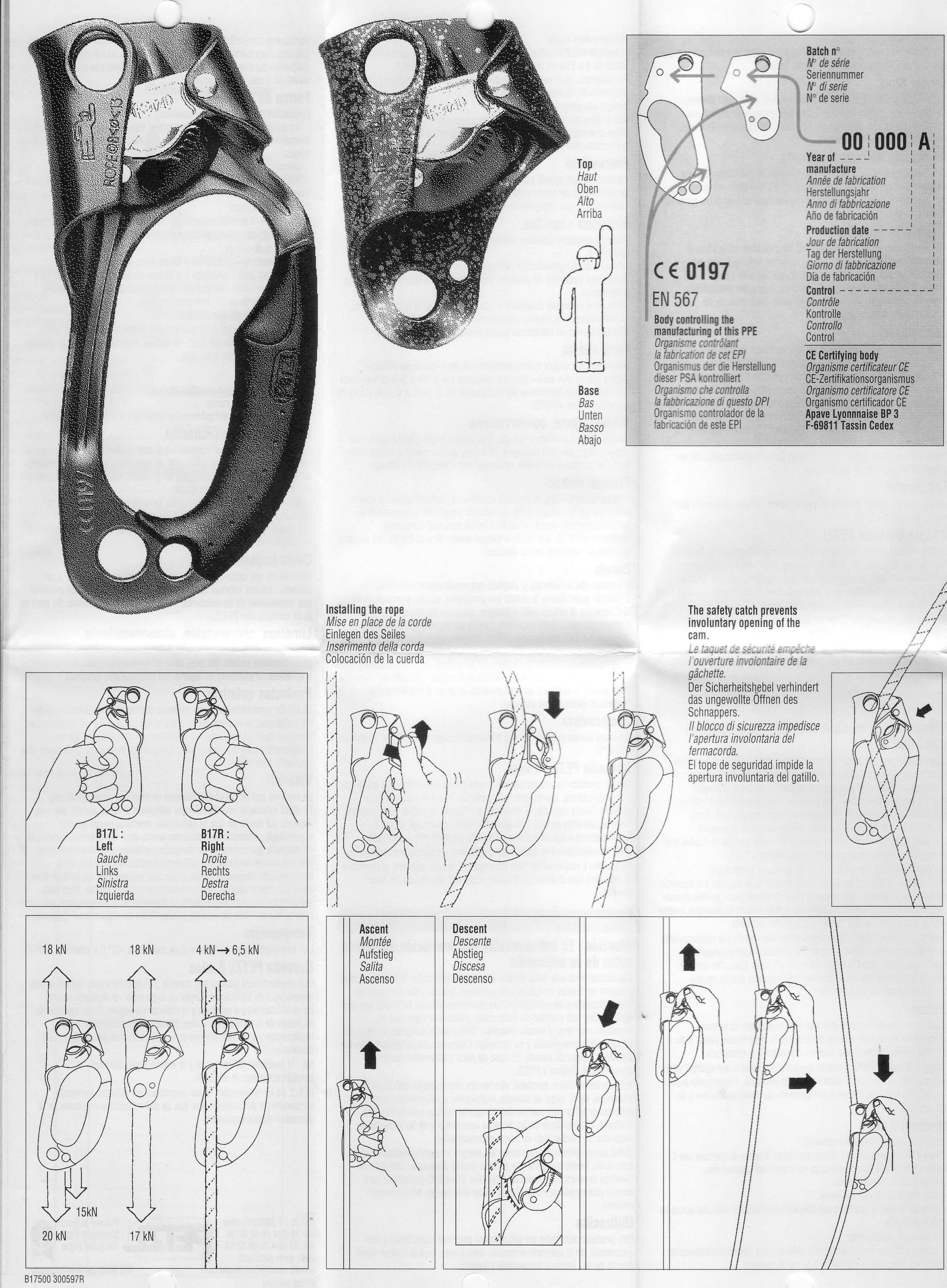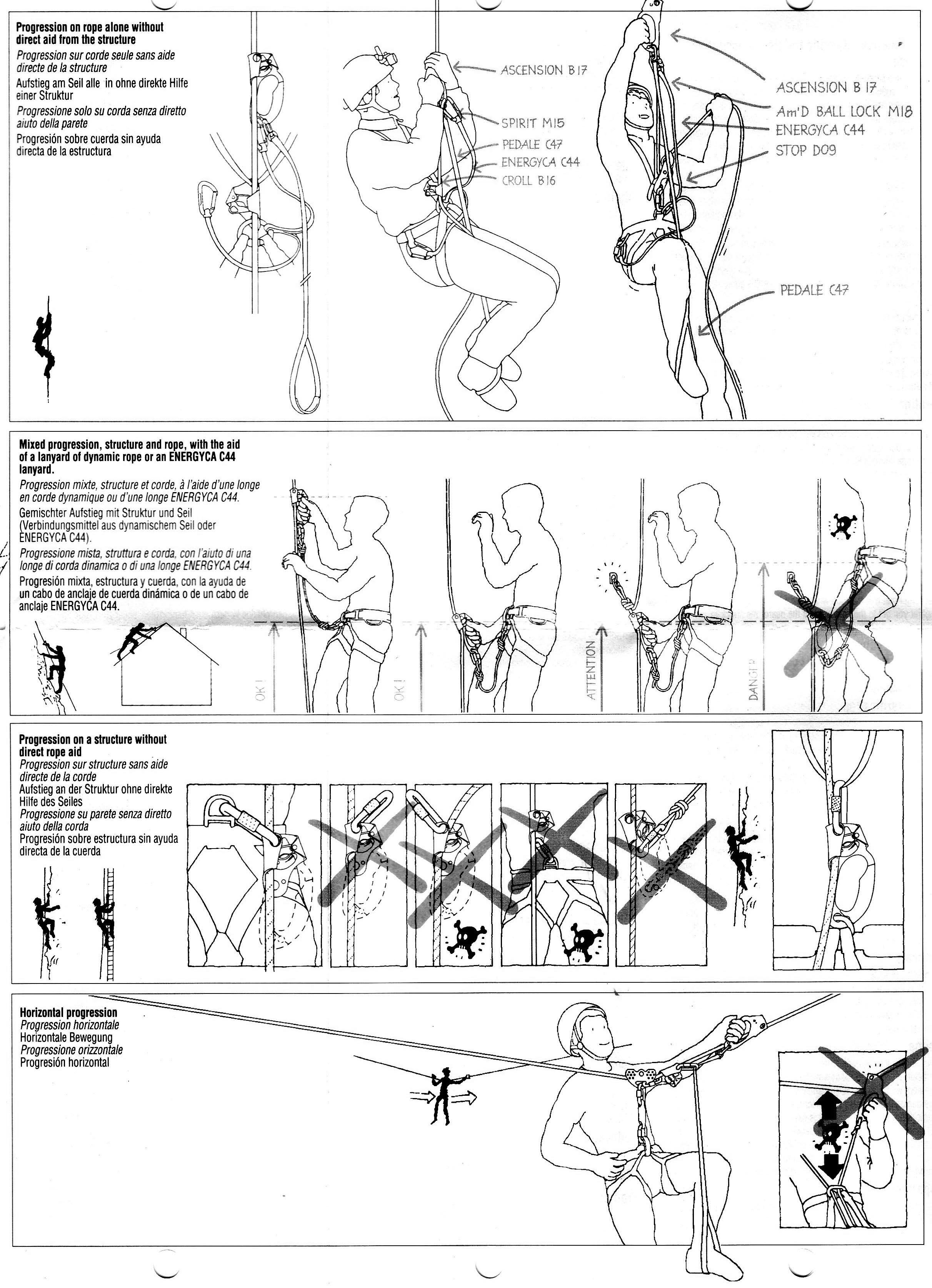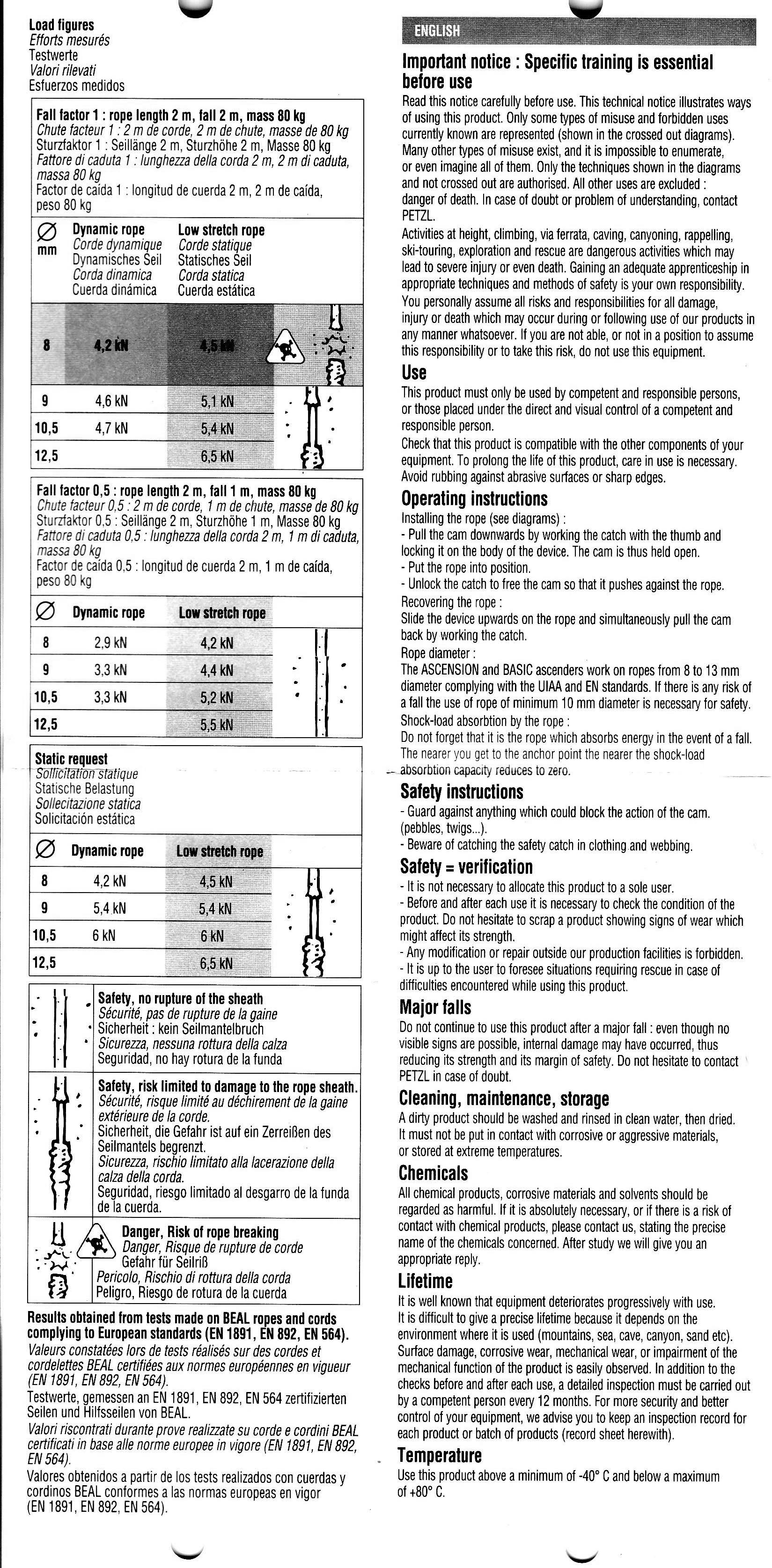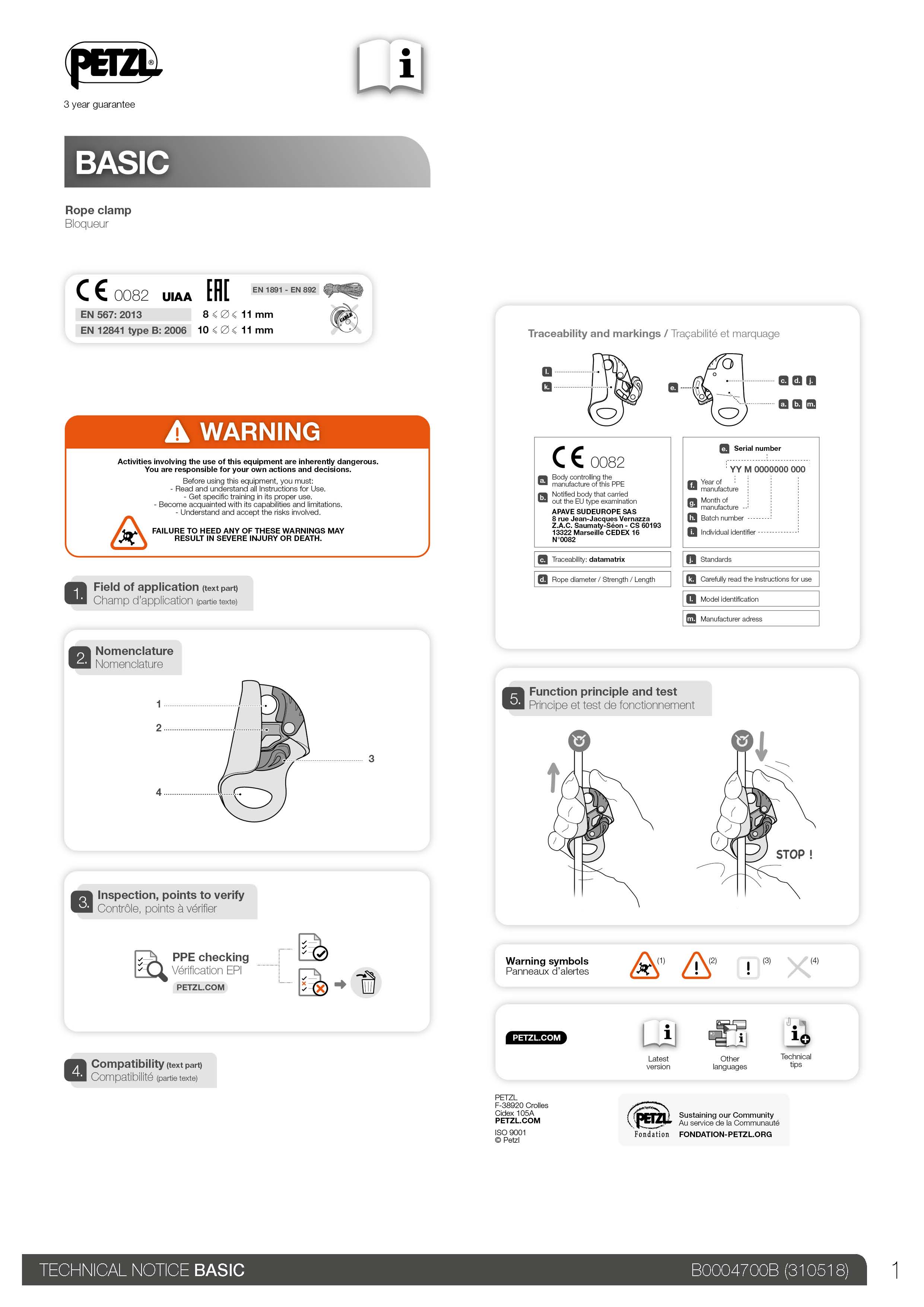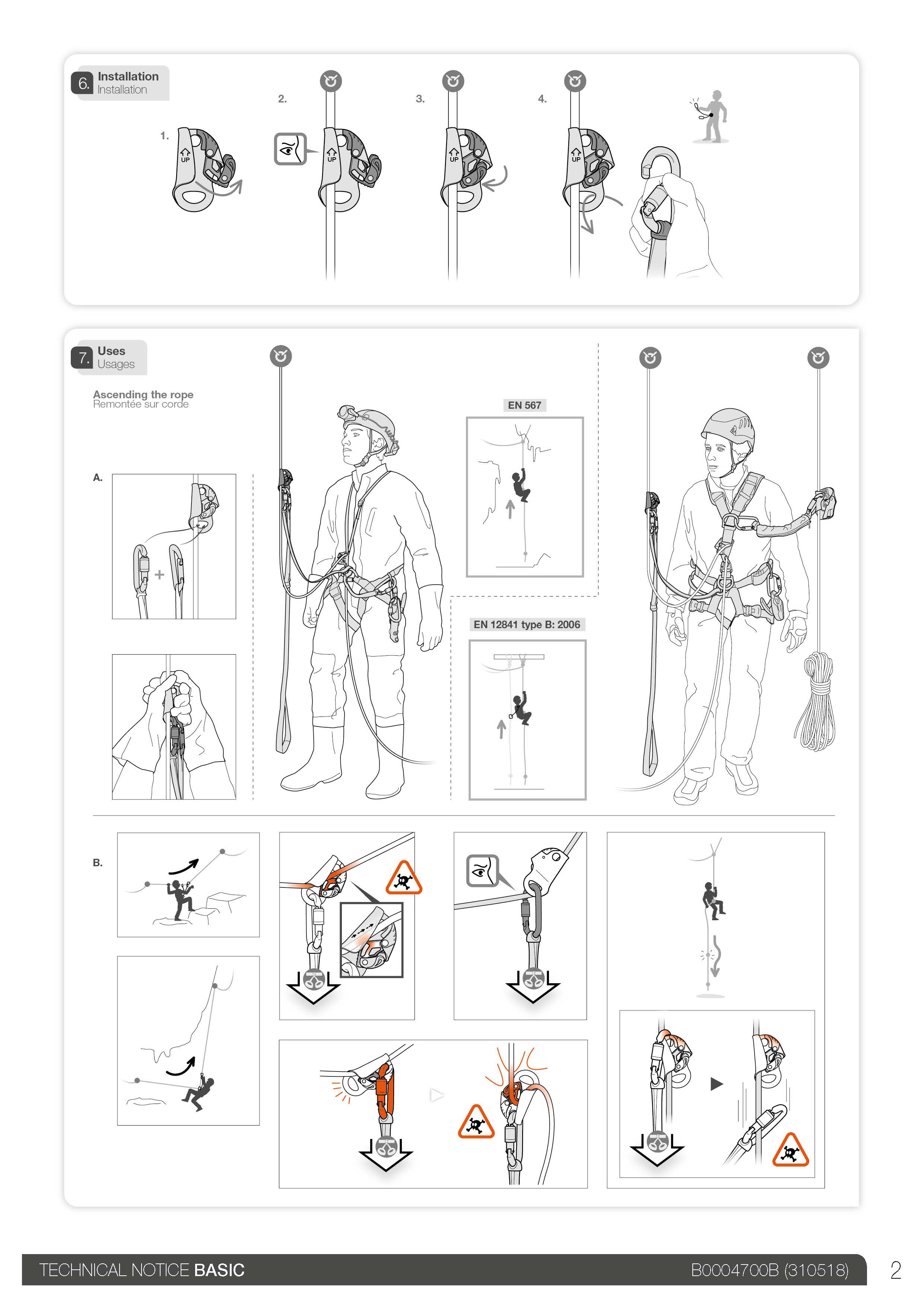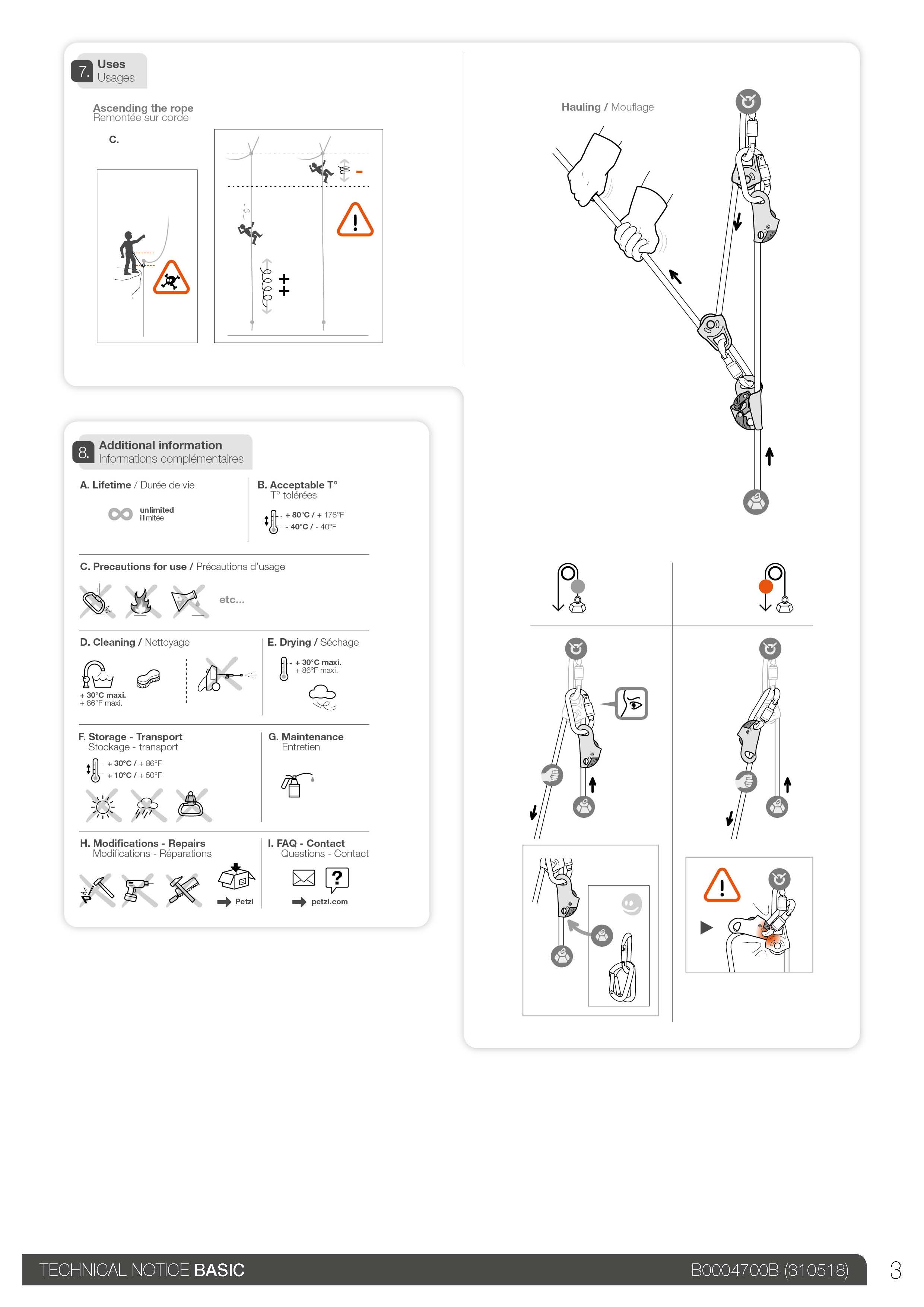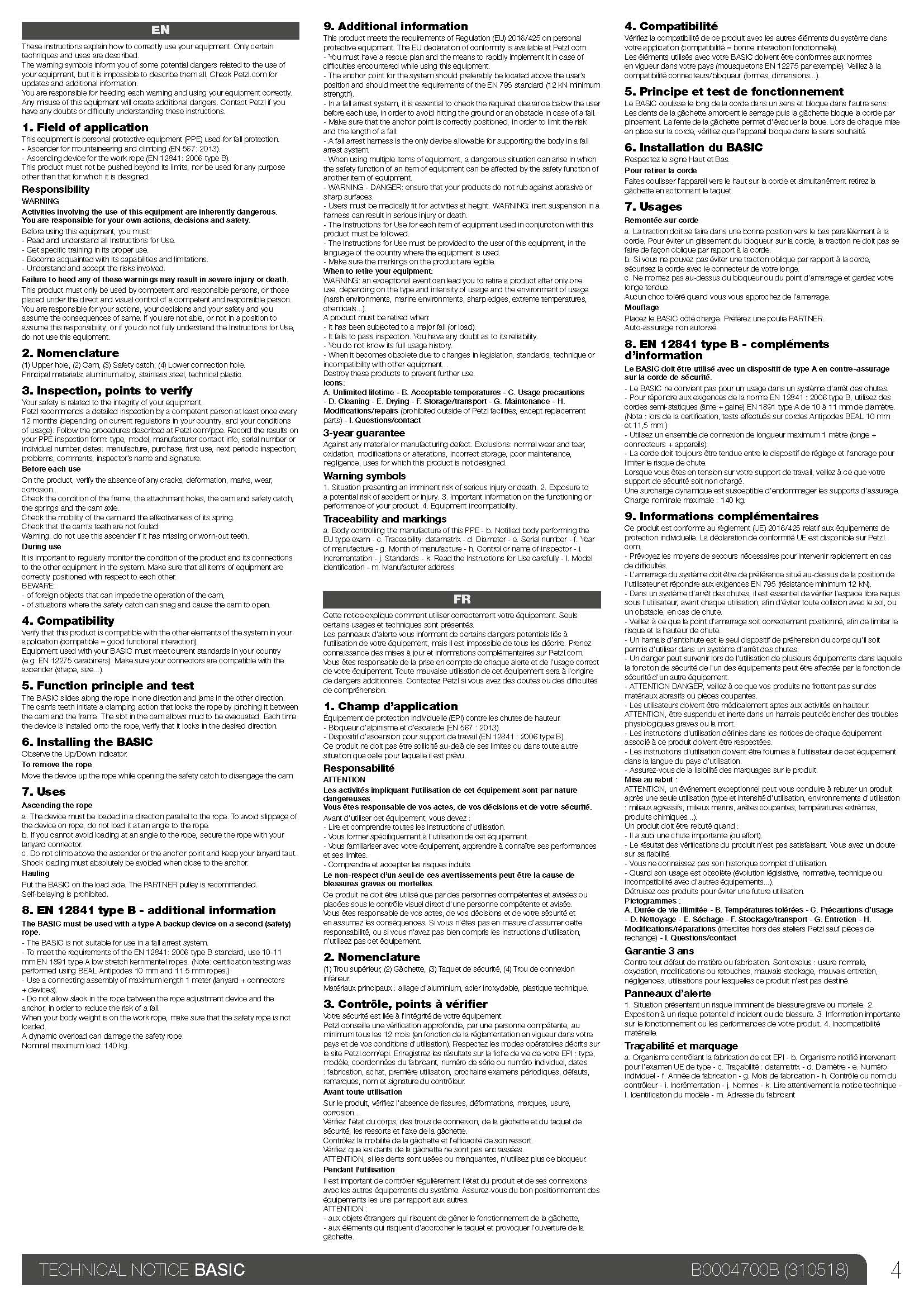
Petzl Basic
(a.k.a. Bloquer, Jammer)
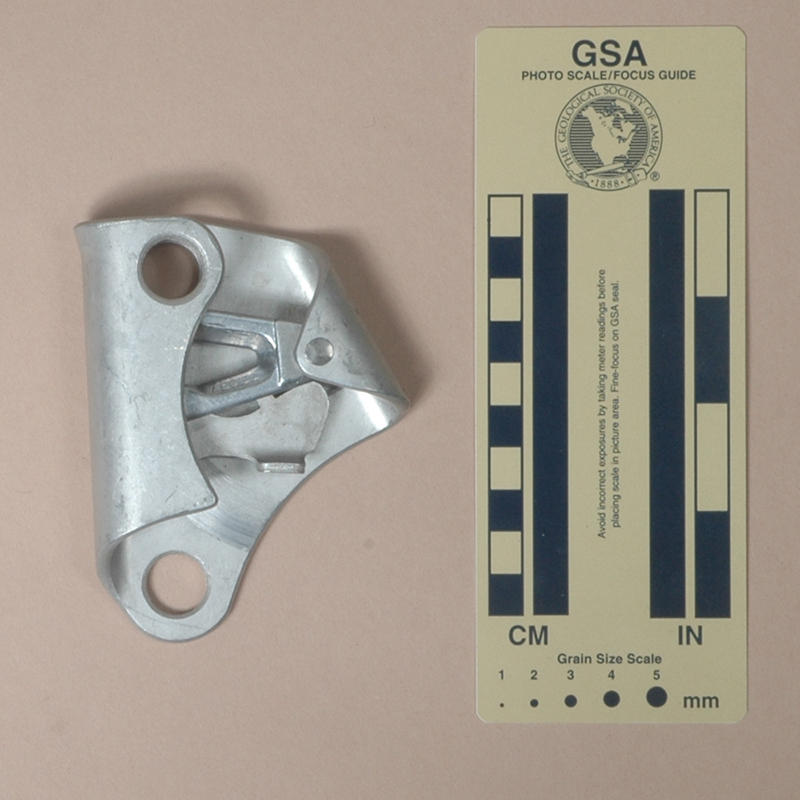
Version A
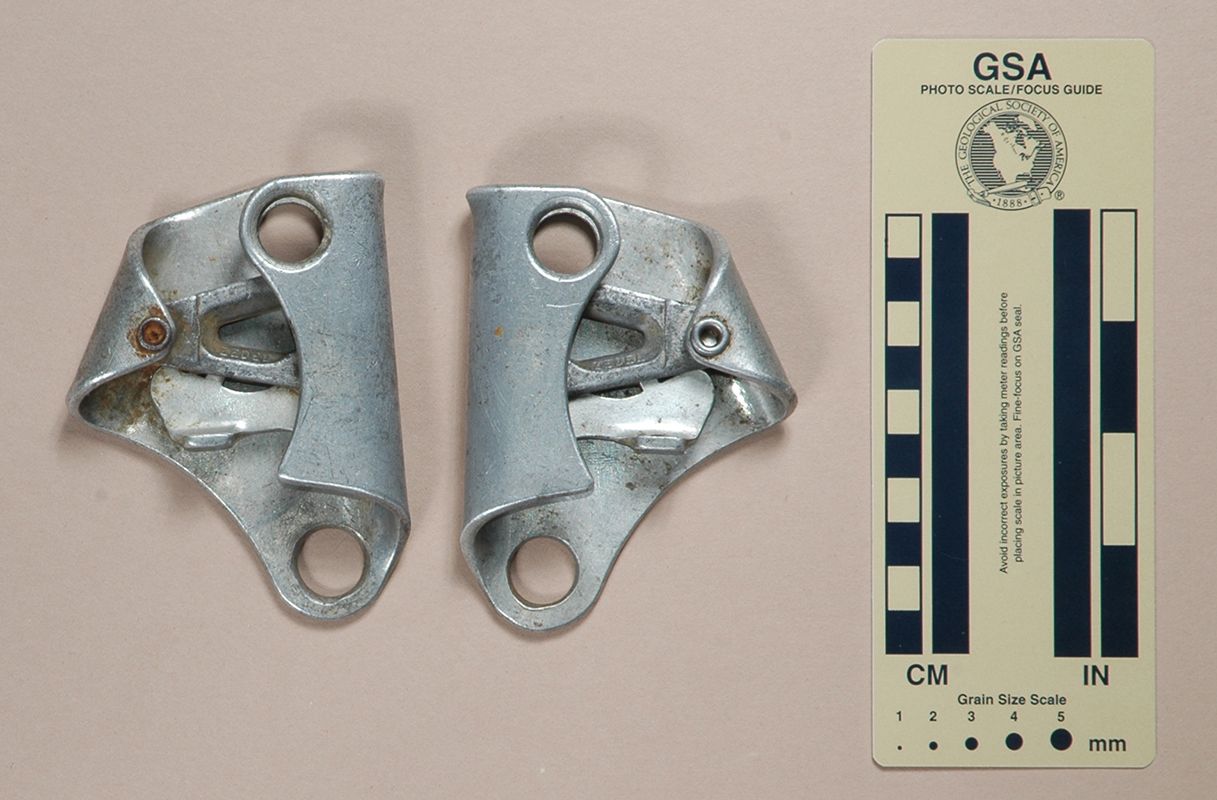
Version B
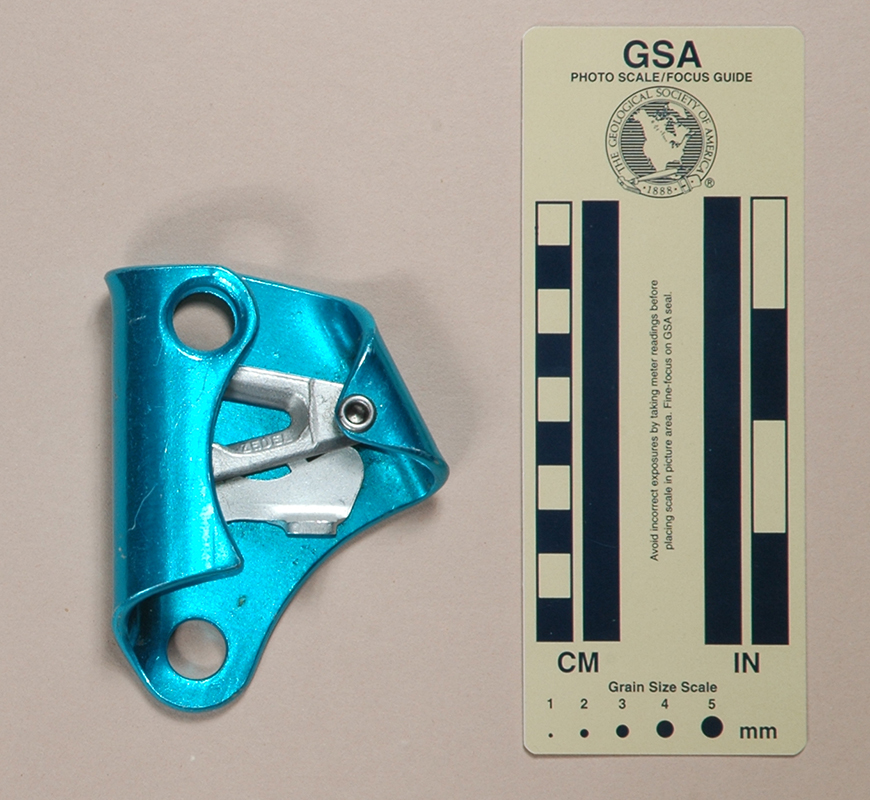
Version C
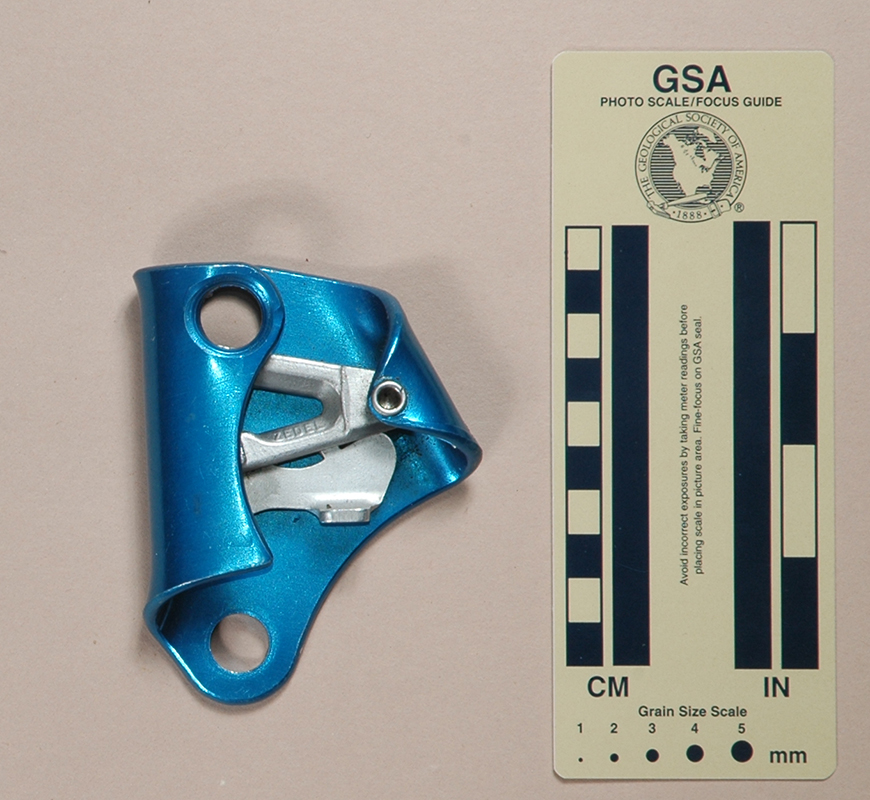
Version D
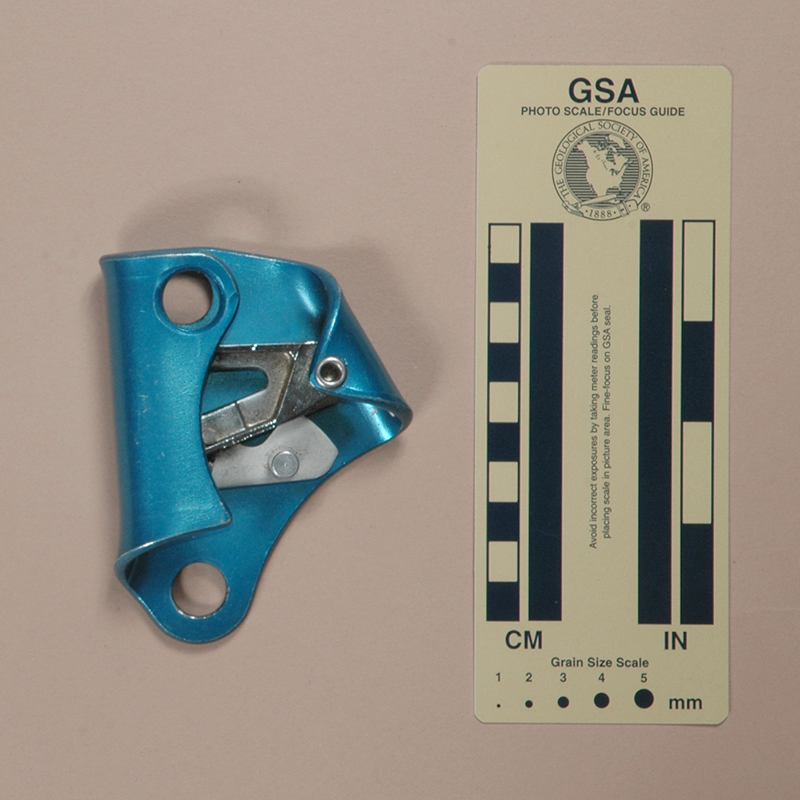
Version E
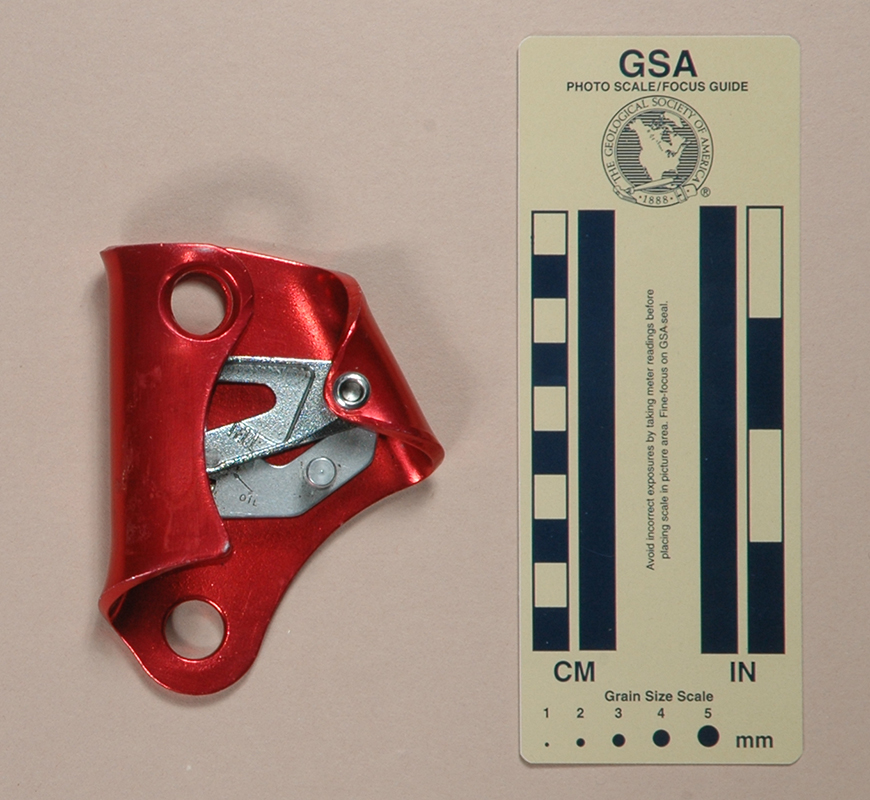
Version F
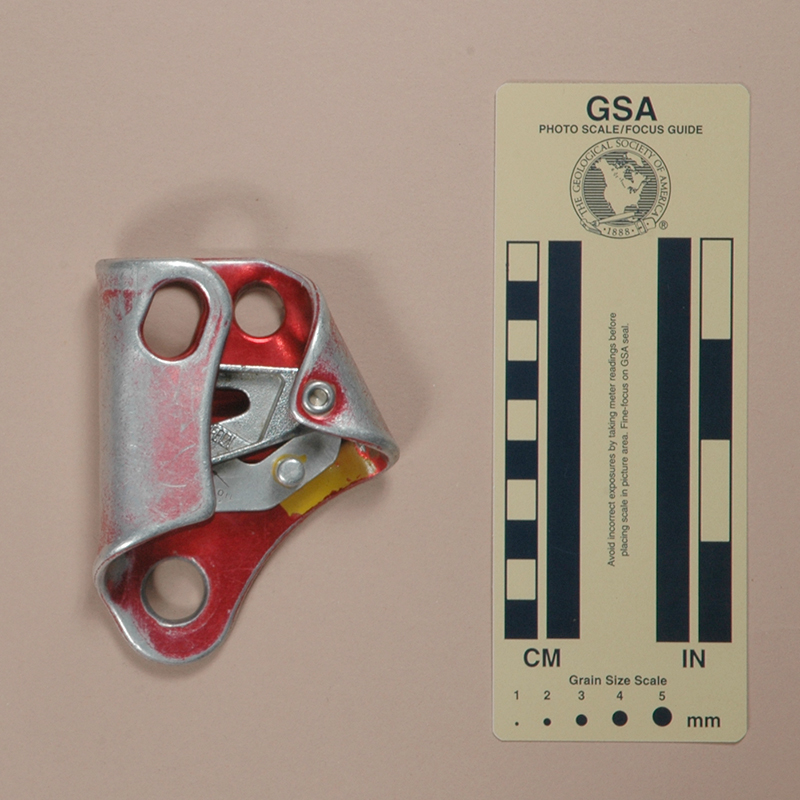
Version G
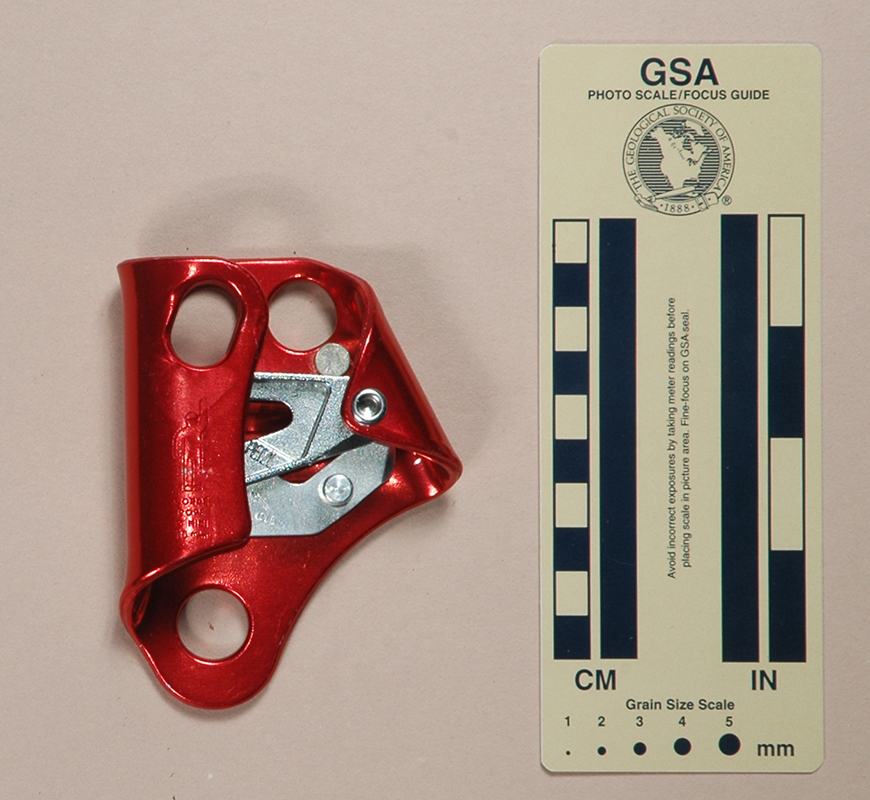
Version H
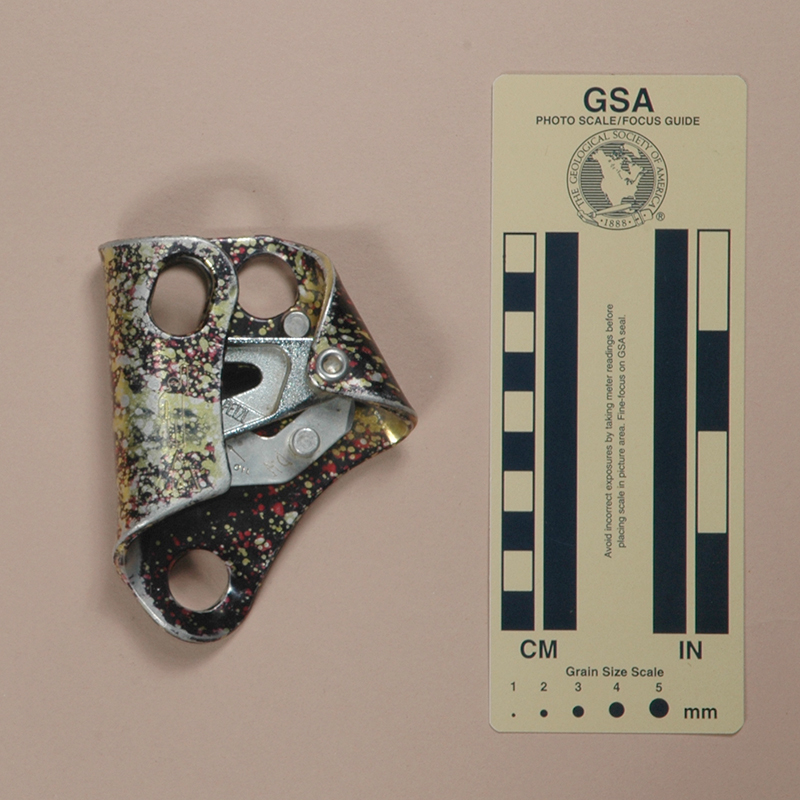
Version I
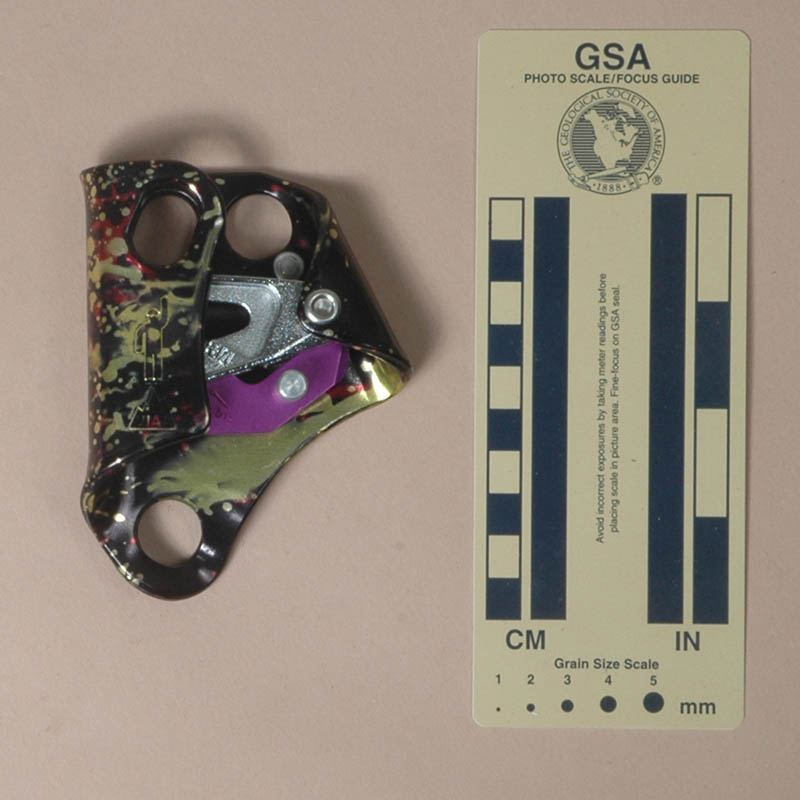
Version J
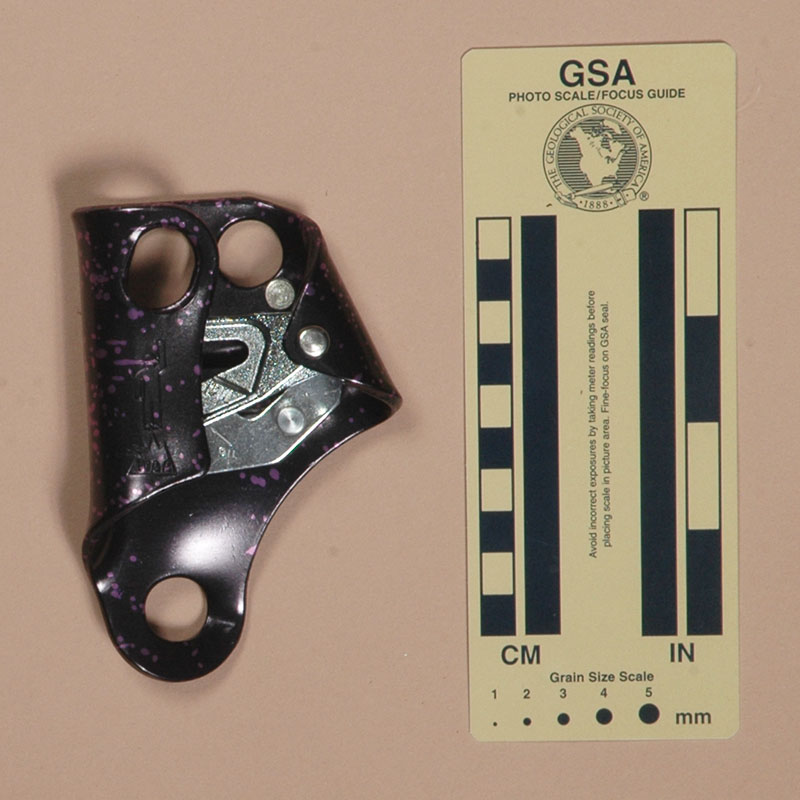
Version K
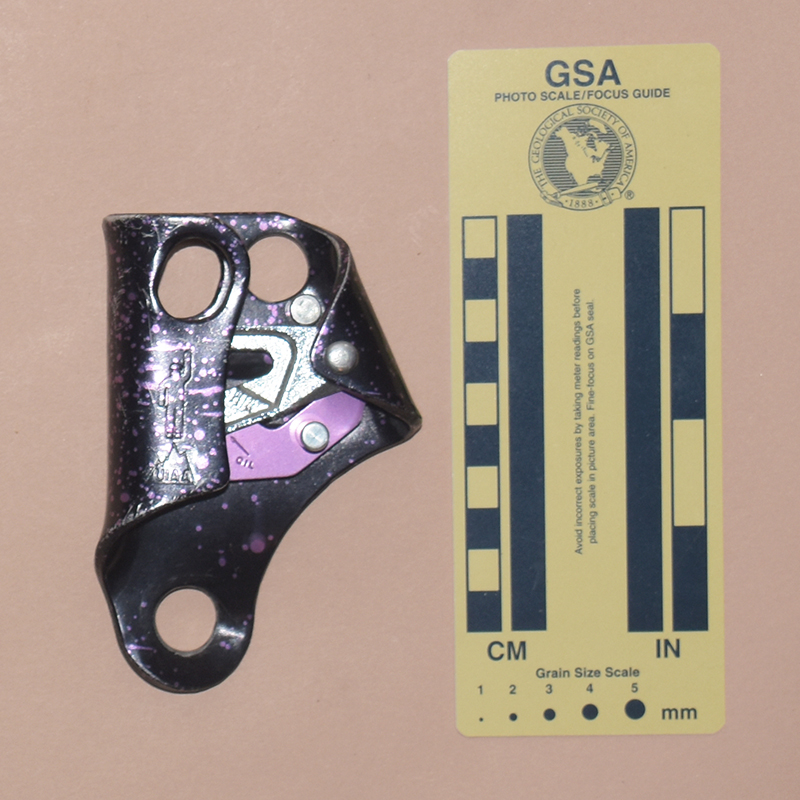
Version L
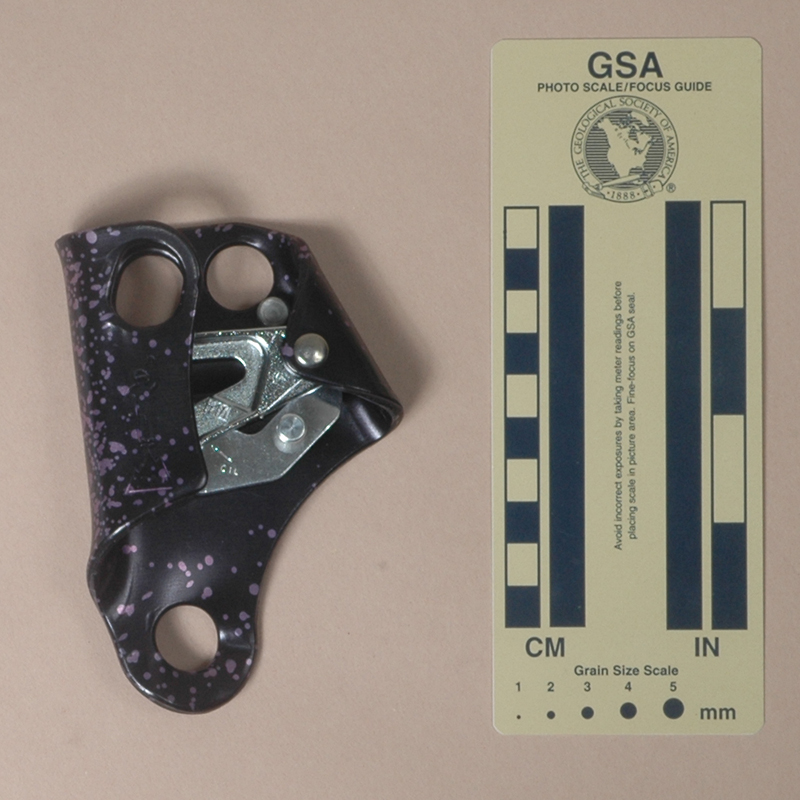
Version M
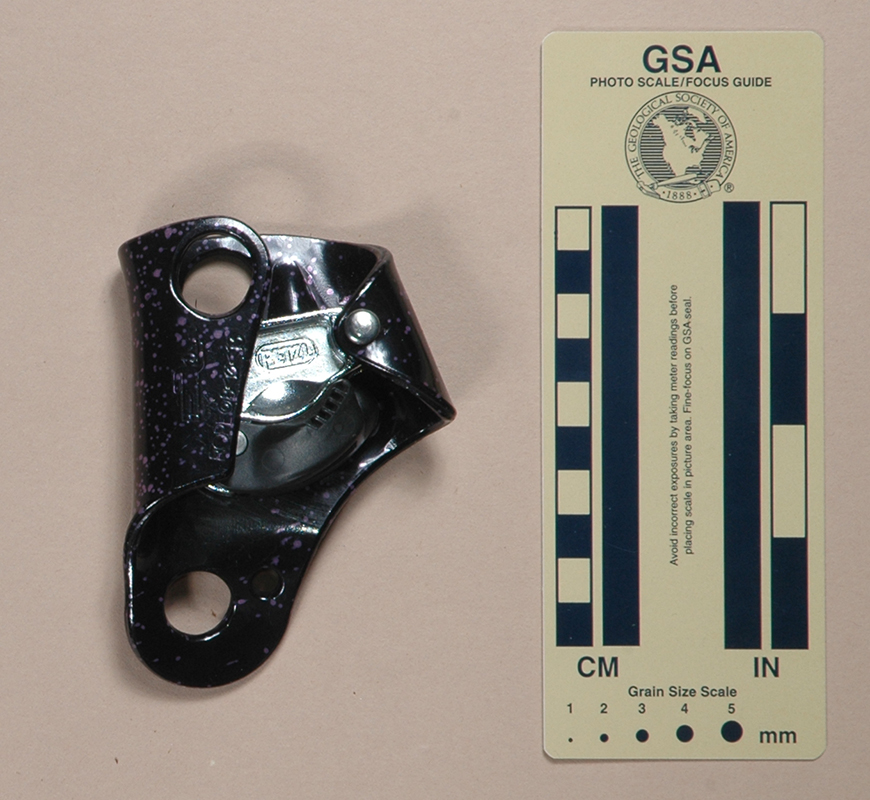
Version N
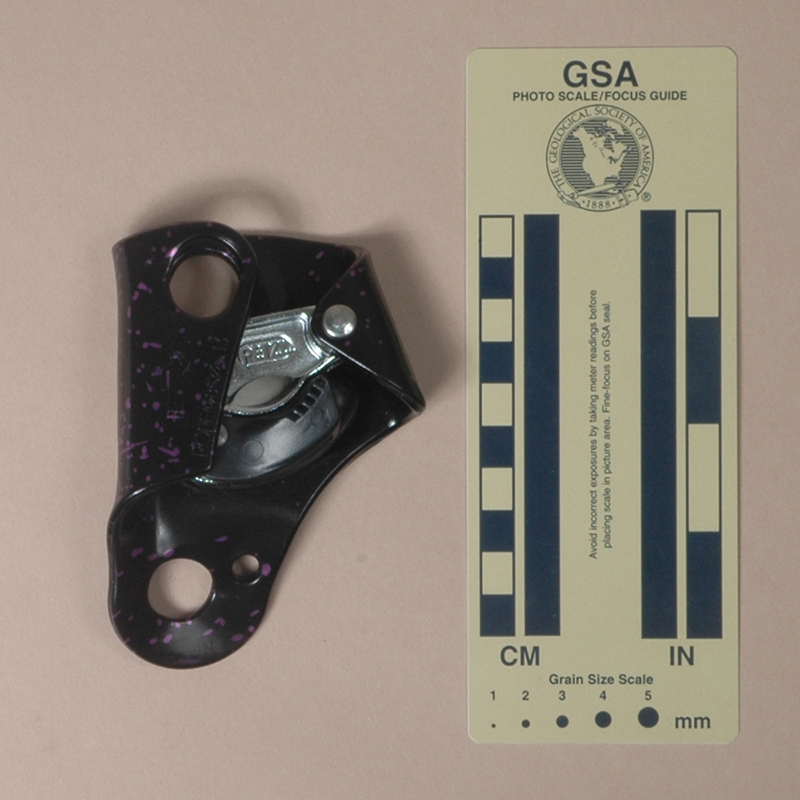
Version O
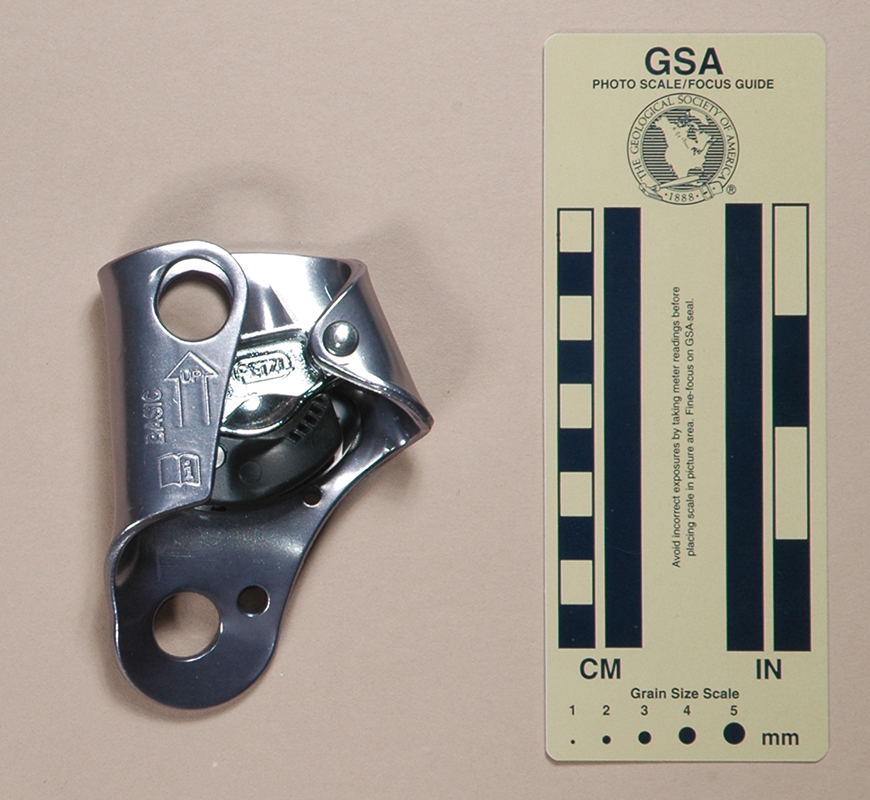
Version P
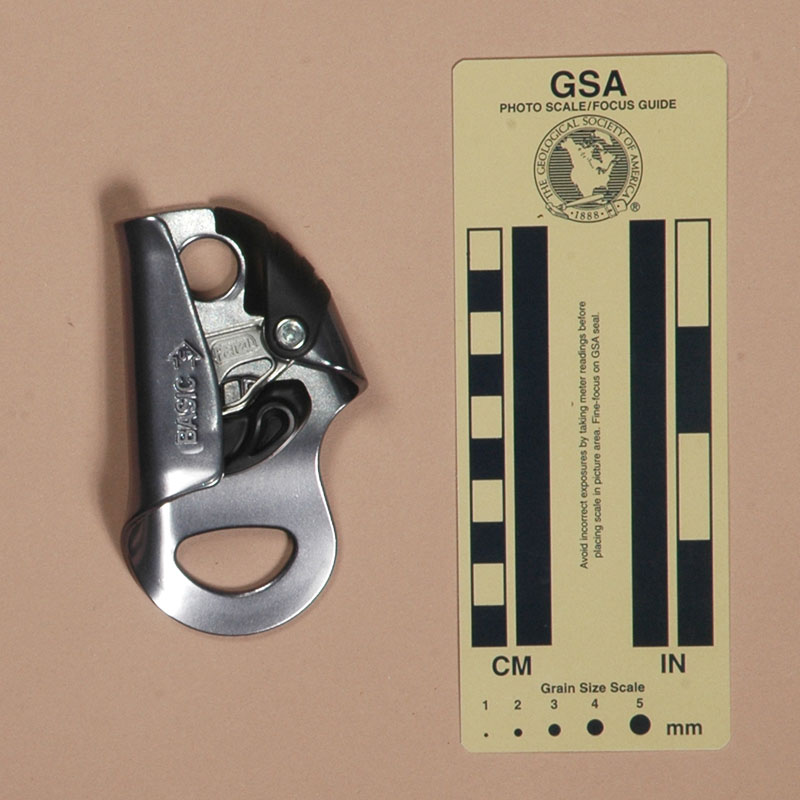
Version Q
Overview
|
 |
The May 2007 Petzl corporate brochure shows a picture of the first Petzl Basic, brought to
market in 1968 under the name "Products Fernand Petzl" (Fernand Petzl Products).
If you can help me get one of the original Petzl Basic ascenders for my collection, please
email me. |
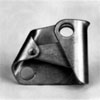 |
|
The Basic (a.k.a. Jammer, a.k.a. Bloquer, a.k.a. Blocker) is a very popular ascender.
Its light weight and small size certainly enhance its popularity. Here is a quick summary of the versions in my collection:
- Z-tooth cam, flat rivets
(#2130)
- Left- and right-handed versions made, Z-tooth cam, semi-tubular rivets
(#202, 1539, 1540, 2129)
- Right-handed only, anodized shell
(#12)
- Lower attachment hole not beveled
(#13)
- New toothed cam with down-climbing flat, new cam safety with pin
(#14, 1592)
- Cam flat eliminated, new cam safety
(#1553)
- Second top hole, reinforced shell
(#1577)
- Round cam stop, slotted cam
(#15)
- New lower shell design
(#1570)
- Anodized safety
(#2066)
- Another new lower shell design
(#1912)
- Anodized safety
(#2917)
- CE stamped, plain safety
(#2083)
- New shell design, stamped cam stop, new cam design, plastic cam safety
(#125)
- Two small holes behind the cam
(#2082, 2918)
- Additional hole below cam
(#277, 2084)
- Smaller, full redesign
(#1943, 2059, 2398)
[ Top
| Version B
| Version C
| Version D
| Version E
| Version F
| Version G
| Version H
| Version I
]
[ Version J
| Version K
| Version L
| Version M
| Version N
| Version O
| Version P
| Version Q
| Return to E.C. Ascenders
]
Version A
(#2130)
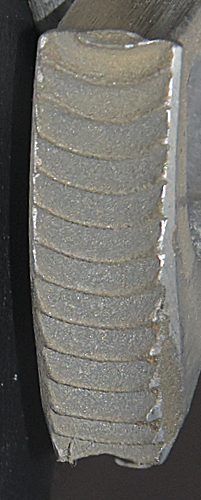 Technical Details
Technical Details
I acquired three Petzl Basic, Version A ascenders in 2017 as part of Bob Thrun’s collection.
This version is 101 mm. tall, 77 mm. wide, 23 mm. thick, and weighs 116 g. The rope channel is 16 mm. wide. The cam radius increases from 40 to 51 mm. over an angle of 43°, giving a 19° cam angle. The cam has 14 "z" teeth
cast into the cam.
The shell has no markings. The cam has "ZEDEL" in raised cast letters.
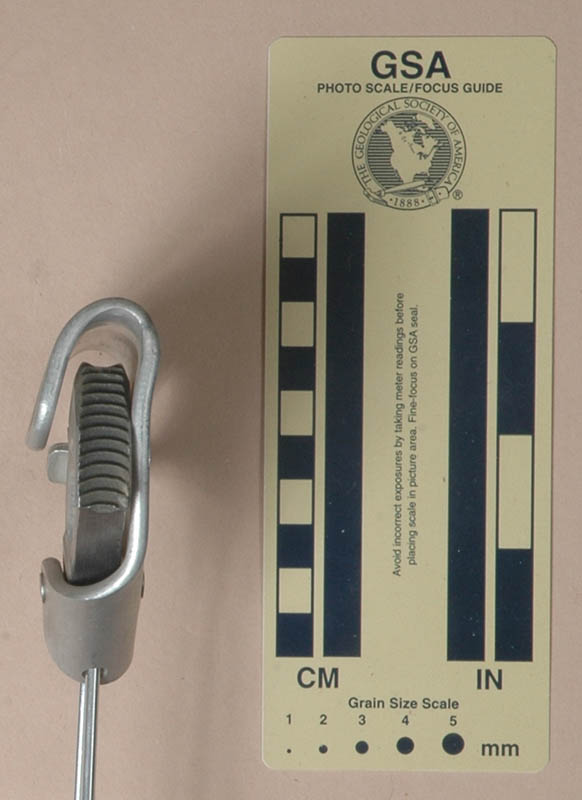
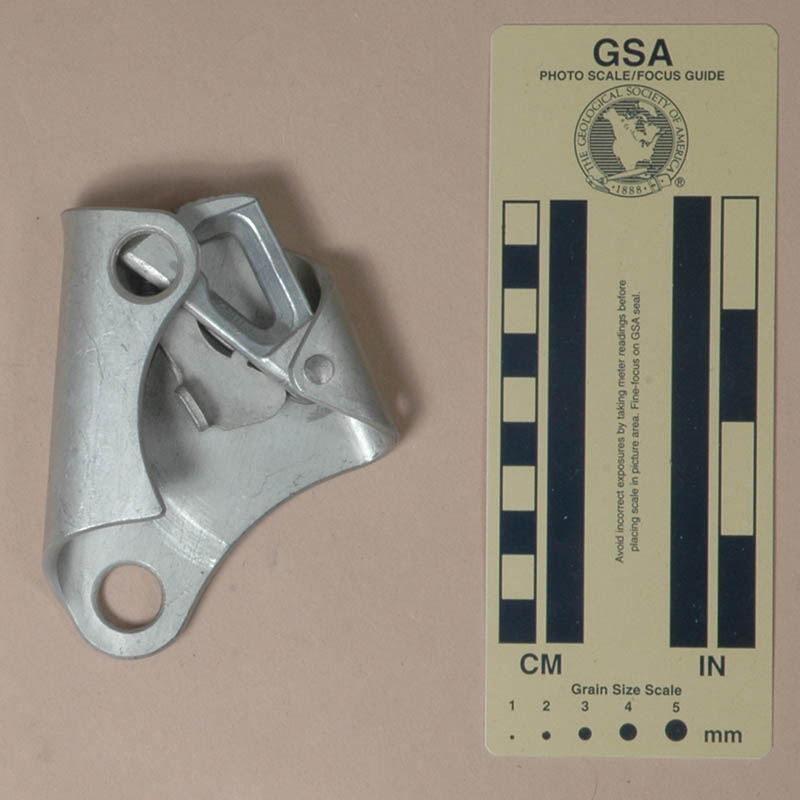 Bob tested one of these ascenders
to failure. That ascender was one of the three that I acquired when I received his collection. He described the test results as follows (Prusiking):
Bob tested one of these ascenders
to failure. That ascender was one of the three that I acquired when I received his collection. He described the test results as follows (Prusiking):
At 800 lbs the body was bending. At
900 lbs, the body sprang apart enough for the cam to swing through.
The ascender was totally inoperable. Even the cam had been bent.
These units are weaker than other mechanical ascenders, but are
comparable in strength to quarter-inch poly slings, which some
cavers use.
Bob Thrun wrote that these
were available in left- and right-handed versions, with and without
safety catch, for a total of four versions.
|
 |
If you can help me acquire any Petzls without the safety catch, please email me. |
|
[ Top
| Version A
| Version C
| Version D
| Version E
| Version F
| Version G
| Version H
| Version I
]
[ Version J
| Version K
| Version L
| Version M
| Version N
| Version O
| Version P
| Version Q
| Return to E.C. Ascenders
]
Version B
(#202, 1539, 1540, 2129)
Technical Details
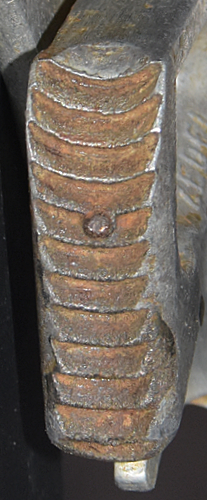 I acquired a right-handed Petzl Basic, Version B from Luc Bourguignon in 2005. In 2010 I acquired a pair from Julian Turner. I acquired another pair in 2017 as part of Bob Thrun’s collection.
I acquired a right-handed Petzl Basic, Version B from Luc Bourguignon in 2005. In 2010 I acquired a pair from Julian Turner. I acquired another pair in 2017 as part of Bob Thrun’s collection.
This version is 100 mm. tall, 76 mm. wide, 24 mm. thick, and weighs 113 g. The rope channel is 16 mm. wide. The cam radius increases from 38 to 51 mm. over an angle of 43°, giving a 22° cam angle. The cam has 12 "z" teeth
cast into the cam, plus a single sprue between the fifth and sixth
"z" teeth.
The back of the shell is stamped "F. PETZL" (inside an oval) and "FRANCE."
The cam has "ZEDEL" in raised cast letters.
Version B has round-headed cam rivets while Version A has countersunk rivets. Aside from the lack of anodizing, the right-handed Version B is essentially the same as Version C.
[ Top
| Version A
| Version B
| Version D
| Version E
| Version F
| Version G
| Version H
| Version I
]
[ Version J
| Version K
| Version L
| Version M
| Version N
| Version O
| Version P
| Version Q
| Return to E.C. Ascenders
]
Version C (B8)
(#12)
Technical Details
I obtained this ascender from Repetto Sport in 1982.
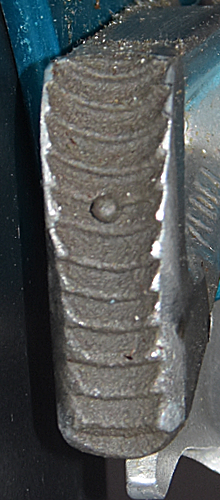 This version is right-handed. The ascender is 100 mm. high, 76 mm. wide,
24 mm. thick, and weighs 122 grams. The ascender shell
is subtriangular light blue anodized shape bent from 4.2 mm.
aluminum sheet. The rope channel is formed by bending the left
side of the ascender into a U. The rope channel is 15 mm.
wide. The main sling attachment point is a beveled 13 mm.
hole located below the cam near the rope channel. A second attachment
point consists of two beveled 13 mm. holes through the rope
channel U and just above the cam. The right end of the shell is
bent on an inclined axis to form another U. A hole drilled through
both sides of the U accepts a semi-tubular rivet. The cam and cam spring
are mounted on this rivet. The head of the rivet sits into a stamped
depression on the back of the cam, while the roll is exposed on
the open side. The pivot is centered 49 mm. from the inside
of the rope groove.
This version is right-handed. The ascender is 100 mm. high, 76 mm. wide,
24 mm. thick, and weighs 122 grams. The ascender shell
is subtriangular light blue anodized shape bent from 4.2 mm.
aluminum sheet. The rope channel is formed by bending the left
side of the ascender into a U. The rope channel is 15 mm.
wide. The main sling attachment point is a beveled 13 mm.
hole located below the cam near the rope channel. A second attachment
point consists of two beveled 13 mm. holes through the rope
channel U and just above the cam. The right end of the shell is
bent on an inclined axis to form another U. A hole drilled through
both sides of the U accepts a semi-tubular rivet. The cam and cam spring
are mounted on this rivet. The head of the rivet sits into a stamped
depression on the back of the cam, while the roll is exposed on
the open side. The pivot is centered 49 mm. from the inside
of the rope groove.
The cam is a plated skeletonized aluminum casting. The cam
radius, measured from the pivot, increases from 40 to 51 mm.
over an angle of 42 degrees. The cam has 12 "z" teeth
cast into the cam, plus a single sprue between the fifth and sixth
"z" teeth. A spring-loaded manual safety bar is mounted
on the bottom of the cam with a solid pin. The normal action of
the spring holds the safety against the cam. When the cam is opened,
the shell interferes with the safety bar, thus preventing opening
the cam. If the safety bar is moved away from the cam (opposing
the spring), it will clear the shell and the cam will open. At
full open the safety can be released and the spring will hold
the safety against the back of the shell. A small tab fits into
a small drilled in the back of the shell cam U and holds the cam
open. A bent tab on the bottom of the safety bar assists in operating
the safety mechanism.
The back of the shell is stamped "F. PETZL" (inside an oval) and "FRANCE."
The cam has "ZEDEL" in raised cast letters.
This ascender dates from the 1960s. The shell is adequate but
the cam is not. The soft cam wears quickly, the teeth are inadequate
in mud, and in general the cam is poorly executed. Versions D
and later are much better ascenders.
[ Top
| Version A
| Version B
| Version C
| Version E
| Version F
| Version G
| Version H
| Version I
]
[ Version J
| Version K
| Version L
| Version M
| Version N
| Version O
| Version P
| Version Q
| Return to E.C. Ascenders
]
Version D (B8)
(#13)
Technical Details
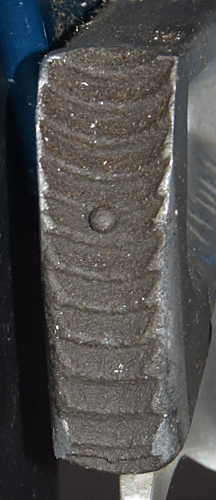 I acquired my Petzl Basic, Version D from Repetto Sport in 1982.
I acquired my Petzl Basic, Version D from Repetto Sport in 1982.
This version is 100 mm. tall, 76 mm. wide, 24 mm. thick, and weighs 119 g. The rope channel is 16 mm. wide. The cam radius increases from 38 to 51 mm. over an angle of 43°, giving a 22° cam angle. The cam has 12 "z" teeth
cast into the cam, plus a single sprue between the fifth and sixth
"z" teeth.
The back of the shell is stamped "PETZL" (inside an oval), "MAXI 400KG," "BREVETE," and "FRANCE."
The cam has "ZEDEL" in raised cast letters.
When I bought this ascender, it was paired with the Version C ascender. Version D does not have the beveled attachment hole that Version C has.
[ Top
| Version A
| Version B
| Version C
| Version D
| Version F
| Version G
| Version H
| Version I
]
[ Version J
| Version K
| Version L
| Version M
| Version N
| Version O
| Version P
| Version Q
| Return to E.C. Ascenders
]
Version E (B8)
(#14, 1592)
Technical Details
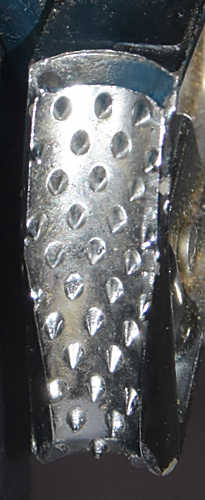 I acquired a pair of these ascenders from Speleoshoppe in 1979, and another in like-new condition from Lee Newman in 2012.
I acquired a pair of these ascenders from Speleoshoppe in 1979, and another in like-new condition from Lee Newman in 2012.
This version is right-handed, 100 mm. high, 76 mm.
wide, 26 mm. thick, and weighs 138 grams. The rope channel is 17 mm. wide. The shell
is essentially identical to Version D except the anodizing
is a darker blue, and the upper end of the rope groove is flared
to 17.5 mm. The lower attachment hole is not beveled.
Version E introduces a new, superior cam and a new cam safety. The cam is a plated skeletonized steel casting. The cam radius,
measured from the pivot, increases from 38 to 52 mm. over
an angle of 38 degrees. The cam has number of small conical teeth,
all of which have their axes approximately parallel to the lower
surface of the cam. The tooth pattern is (F)(3.4)^3(3.2)^2. The
F stands for a short flat area designed to allow the user to cant
the ascender and slide it down the rope without opening the cam.
A spring-loaded manual safety bar is mounted on the bottom of
the cam with a somewhat cracked steel semi-tubular rivet. The normal action
of the spring holds the safety against the cam. When the cam is
opened, the shell interferes with the safety bar, thus preventing
opening the cam. If the safety bar is moved away from the cam
(opposing the spring), it will clear the shell and the cam will
open. At full open the safety can be released and the spring will
hold the safety against the back of the shell. This provides a
means of locking the cam open. A cylindrical knob on the safety
bar assists in operating the safety mechanism. The shell detent is omitted since the
new cam safety design does not require it.
 The
back of the shell is stamped "PETZL" inside an oval, "MAXI 400
KG," "BREVETE," and "FRANCE."
The
back of the shell is stamped "PETZL" inside an oval, "MAXI 400
KG," "BREVETE," and "FRANCE."
With the advent of the steel cam, the Petzl Jammer became a
viable ascender. The ascender is well made, and the cam teeth
are among the finest in my collection. The only oversight is that
the lower attachment hole is not beveled. Single-handed operation
of the Jammer is rather difficult. Left-handed operation particularly
difficult as expected for a right-handed ascender.
The flat area on the cam caused some confusion. Some cavers
thought it was a design defect, but actually it was provided as
a feature. The flat area allows one to cant the ascender then
slide it down the rope without opening the cam. This feature was
later abandoned.
[ Top
| Version A
| Version B
| Version C
| Version D
| Version E
| Version G
| Version H
| Version I
]
[ Version J
| Version K
| Version L
| Version M
| Version N
| Version O
| Version P
| Version Q
| Return to E.C. Ascenders
]
Version F (B8)
(#1553)
Technical Details
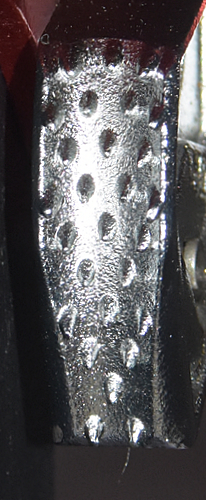 I acquired my Petzl Basic, Version F from Julia Bloomer in 2011
I acquired my Petzl Basic, Version F from Julia Bloomer in 2011
This version is 102 mm. tall, 78 mm. wide, 24 mm. thick, and weighs 141 g. The rope channel is 17 mm. wide. The cam radius increases from 38 to 53 mm. over an angle of 37°, giving a 28° cam angle. The tooth pattern is (3.4)^2(3.2)^2(1.2).
The
back of the shell is stamped "PETZL" inside an oval, "MAXI 400
KG," "BREVETE," and "FRANCE." The cam has "PETZL" in raised letters on both sides. Each side of the cam safety has an arrow pointing toward the safety pivot and the word "OIL" underneath.
This ascender features a new cam design that eliminates the cam flat and reduces the number of teeth. The safety has a new shape as well.
[ Top
| Version A
| Version B
| Version C
| Version D
| Version E
| Version F
| Version H
| Version I
]
[ Version J
| Version K
| Version L
| Version M
| Version N
| Version O
| Version P
| Version Q
| Return to E.C. Ascenders
]
Version G (B08)
(#1577)
Technical Details
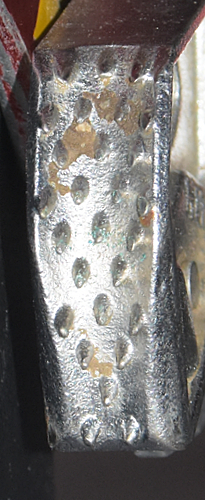 I acquired my Petzl Basic, Version G from Julia Bloomer in 2011.
I acquired my Petzl Basic, Version G from Julia Bloomer in 2011.
This version is 102 mm. tall, 78 mm. wide, 24 mm. thick, and weighs 141 g. The rope channel is 17 mm. wide. The shell
has two significant improvements over Version F. First, this version adds a second, 12.5 mm. diameter upper attachment hole that goes through
the back of the ascender only, missing the rope groove. Second, a raised
area is stamped into the back of the ascender, increasing
the rigidity of the shell.
The cam radius increases from 38 to 53 mm. over an angle of 37°, giving a 28° cam angle. The tooth pattern is (3.4)^2(3.2)^2(1.2). A cylindrical knob on the safety bar assists in operating
the safety mechanism.
The back of the shell is stamped with the Petzl logo, "MAXI
400 KG," and "BREVETE FRANCE." The word "PETZL"
is cast into each side of the cam, and "OIL" and an
arrow are stamped on each side of the cam safety.
This version’s shell design
is superior to the previous one, and I see no significant disadvantage to the changes, other than the minor increase in ascender thickness. The extra hole is occasionally be useful, depending on which climbing system one chooses to use with this ascender.
[ Top
| Version A
| Version B
| Version C
| Version D
| Version E
| Version F
| Version G
| Version I
]
[ Version J
| Version K
| Version L
| Version M
| Version N
| Version O
| Version P
| Version Q
| Return to E.C. Ascenders
]
Version H (B08)
(#15)
Technical Details
I obtained this ascender from Bob & Bob at the
1988 NSS convention.
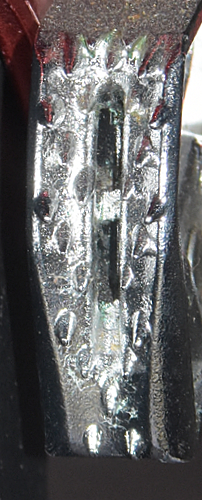 This version is right-handed, 100 mm. high, 76 mm.
wide, 26 mm. thick, and weighs 145 grams. The rope channel is 15 mm. wide. The shell
has a few minor improvements over Version F. The upper attachment
hole has been enlarged to a near vertical 19x13.5 mm. oval.
A second 15 mm. upper attachment hole is provided. It goes through
the back of the ascender only, missing the rope groove. All holes are beveled. A raised
area is stamped into the back of the ascender, increasing
the rigidity of the shell. A cylindrical cam closing stop is
provided.
This version is right-handed, 100 mm. high, 76 mm.
wide, 26 mm. thick, and weighs 145 grams. The rope channel is 15 mm. wide. The shell
has a few minor improvements over Version F. The upper attachment
hole has been enlarged to a near vertical 19x13.5 mm. oval.
A second 15 mm. upper attachment hole is provided. It goes through
the back of the ascender only, missing the rope groove. All holes are beveled. A raised
area is stamped into the back of the ascender, increasing
the rigidity of the shell. A cylindrical cam closing stop is
provided.
The cam radius increases from 38 to 52 mm. over an angle of 37°, giving a 25° cam angle. The tooth pattern is (2.3)(2S2.1S1)^2(1S1)^3(1.2). The cam is identical to the one on similar vintage Petzl
Croll ascenders, but the cam safety is shaped differently.
The large semicircle is eliminated, and a simple elbow shape is
used. A cylindrical knob on the safety bar assists in operating
the safety mechanism.
The back of the shell is stamped "PETZL," "MAXI
400 KG," and "BREVETE FRANCE." The front of the
shell is stamped "CORDE," "ROPE," "Ø
MINI." and "10 m/m." A Sieg
Heil icon is also stamped onto the front. The word "PETZL"
is cast into each side of the cam, and "OIL" and an
arrow are stamped on each side of the cam safety.
This version has a slightly more convenient shell design
than the previous one. The comments on the similar Petzl
Croll cam slots apply here as well. The cam
safety design is more reasonable than that on the Croll.
In general this is a well made ascender suitable for a wide range
of uses. I see no practical advantage to the cam stop.
Paul and Pierre Petzl applied for a patent on the Basic Ascender in 1985 and received French Patent #2,589,211 in 1987. They filed for another in1986, and received French Patent #2,600,898 in 1988. The ascender shown in the patent drawings for the first patent features the cam stop, and the second features the cam slot.
[ Top
| Version A
| Version B
| Version C
| Version D
| Version E
| Version F
| Version G
| Version H
]
[ Version J
| Version K
| Version L
| Version M
| Version N
| Version O
| Version P
| Version Q
| Return to E.C. Ascenders
]
Version I (B08)
(#1570)
Technical Details
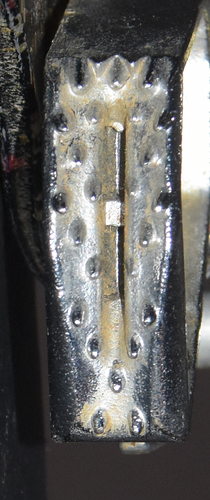 I acquired my Petzl Basic, Version I from Dane Hardinge in 2012.
I acquired my Petzl Basic, Version I from Dane Hardinge in 2012.
This version is 102 mm. tall, 78 mm. wide, 29 mm. thick, and weighs 144 g. The rope channel is 15 mm. wide. The lower shell is no longer flat; instead it is angled. The upper attachment
hole has been enlarged to a near vertical 19.7x13.7 mm. oval.
A second 15.5 mm. upper attachment hole is provided. It goes through
the back of the ascender only, missing the rope groove. A raised
area is stamped into the back of the ascender, increasing
the rigidity of the shell. A cylindrical cam closing stop is
provided.
The cam is a revised skeletonized casting, plated as before.
The cam radius, measured from the pivot, increases from 40 to
53 mm. over an angle of 37 degrees. The cam has number of
small conical teeth, all of which have their axes approximately
parallel to the upper surface of the cam. The cam has number of
small conical teeth, all of which have their axes approximately
parallel to the lower surface of the cam. The tooth pattern is
(2.3)(2S2.1S1)^2(1S1)^3(1.2), where the "S"s stand for
a single longitudinal slot designed for mud removal.
The back of the shell is stamped with the Petzl logo and "BREVETE FRANCE." A Sieg
Heil icon is stamped onto the front above a UIAA logo. The word "PETZL"
is cast into each side of the cam, and "OIL" and an
arrow are stamped on each side of the cam safety.
This version has a slightly more convenient shell design
than the previous one. The extra hole may occasionally be useful,
and this time all holes are beveled.
The slot in the cam is
intended to reduce the risk of ascender slippage due to mud-caked
cam teeth. The design appears superior to the holes on the Kong-Bonaiti Cam-Clean, but the slot is too
small and it is obstructed by a reinforcing rib. Like the Kong-Bonaiti, I believe that most ropes muddy
enough to stop other ascenders will stop the this one too. Although
I have not tried this ascender in the appropriate conditions,
I doubt that the slot will eliminate the icing problems
common to other toothed cam ascenders.
The cam
safety design is more reasonable than that on the Croll.
In general, this is a well made ascender suitable for a wide range
of uses, but the bird droppings finish (a.k.a. spew-vomit) is aesthetically repulsive.
[ Top
| Version A
| Version B
| Version C
| Version D
| Version E
| Version F
| Version G
| Version H
| Version I
]
[ Version K
| Version L
| Version M
| Version N
| Version O
| Version P
| Version Q
| Return to E.C. Ascenders
]
Version J (B08)
(#2066)
Technical Details
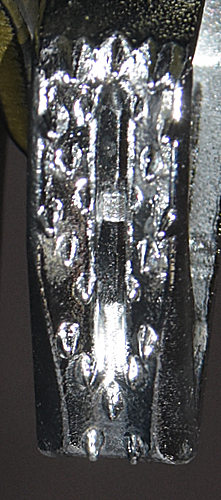 I acquired my Petzl Basic, Version J as part of Bob Thrun’s collection.
I acquired my Petzl Basic, Version J as part of Bob Thrun’s collection.
This version is 102 mm. tall, 78 mm. wide, 31 mm. thick, and weighs 147 g. The rope channel is 15 mm. wide. The lower shell is no longer flat; instead it is angled. The upper attachment
hole has been enlarged to a near vertical 19.7x13.7 mm. oval.
A second 15.5 mm. upper attachment hole is provided. It goes through
the back of the ascender only, missing the rope groove. A raised
area is stamped into the back of the ascender, increasing
the rigidity of the shell. A cylindrical cam closing stop is
provided.
The cam is a revised skeletonized casting, plated as before.
The cam radius, measured from the pivot, increases from 38 to 52 mm. over an angle of 37°, giving a 25° cam angle. The cam has number of
small conical teeth, all of which have their axes approximately
parallel to the upper surface of the cam. The cam has number of
small conical teeth, all of which have their axes approximately
parallel to the lower surface of the cam. The tooth pattern is
(2.3)(2S2.1S1)^2(1S1)^3(1.2), where the "S"s stand for
a single longitudinal slot designed for mud removal.
The back of the shell is stamped with the Petzl logo and "BREVETE FRANCE." A Sieg
Heil icon is stamped onto the front above a UIAA logo. The word "PETZL"
is cast into each side of the cam, and "OIL" and an
arrow are stamped on each side of the cam safety.
Version J has an anodized cam safety while Version I does not; otherwise, they are essentially identical.
[ Top
| Version A
| Version B
| Version C
| Version D
| Version E
| Version F
| Version G
| Version H
| Version I
]
[ Version J
| Version L
| Version M
| Version N
| Version O
| Version P
| Version Q
| Return to E.C. Ascenders
]
Version K (B08)
(#1912)
Technical Details
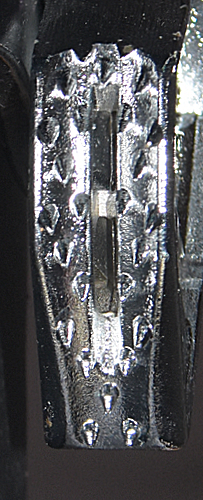 I acquired my Petzl Basic, Version K from ezAuctionDropOff (eBay) in 2012.
I acquired my Petzl Basic, Version K from ezAuctionDropOff (eBay) in 2012.
This version is 115 mm. tall, 76 mm. wide, 26 mm. thick, and weighs 150 g. The rope channel is 15 mm. wide. The lower shell is extended compared to the previous version; otherwise, the two versions are essentially identical except for the paint color.
The back of the shell is stamped with the Petzl logo and "BREVETE FRANCE." A Sieg
Heil icon is stamped onto the front above a UIAA logo. The word "PETZL"
is cast into each side of the cam, and "OIL" and an
arrow are stamped on each side of the cam safety.
In my opinion, the extending the shell has no practical benefit to offset the size increase.
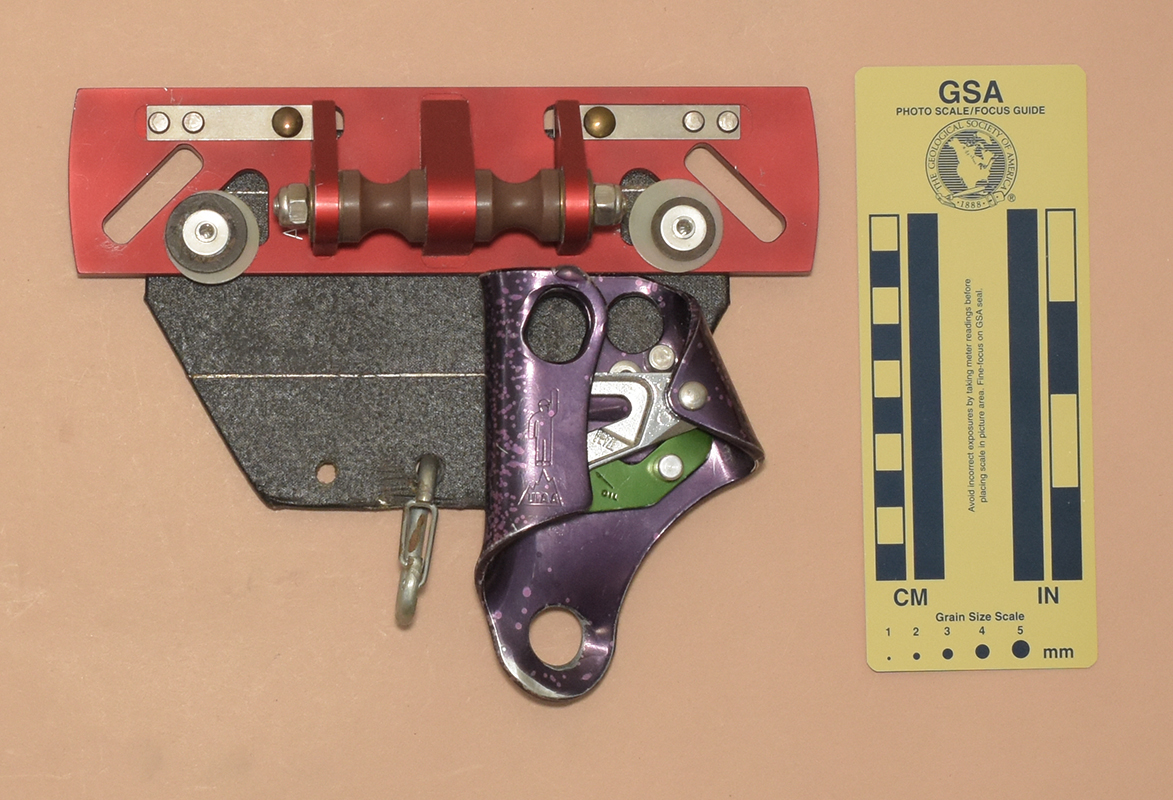 Version L/M
Version L/M
I kave a modified Fritzke Alpine Box with an added Petzl Basic. That Basic has an anodized Version L safety but otherwise matches my Version M.
[ Top
| Version A
| Version B
| Version C
| Version D
| Version E
| Version F
| Version G
| Version H
| Version I
]
[ Version J
| Version K
| Version L
| Version M
| Version O
| Version P
| Version Q
| Return to E.C. Ascenders
]
Version N (B08)
(#125)
Technical Details
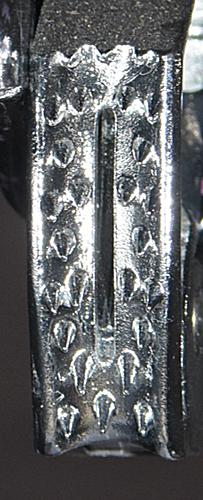 I obtained this ascender from Bob & Bob at the
1997 NSS convention.
I obtained this ascender from Bob & Bob at the
1997 NSS convention.
This version is right-handed, 102 mm. high, 76 mm.
wide, 35 mm. thick, and weighs 139 grams. The rope channel is 15 mm. wide. The shell
has a few minor changes from Version K. First, the back is
not flat; instead, the lower part of the shell bends backward.
The upper attachment hole is shorter and wider, measuring 18.6x16.6 mm.
oval. There is no second upper attachment hole; instead, a triangular
cam stop is punched from rear to front. Its location is too high
to reach the cam. A raised area is stamped into the back of the
ascender, presumably to increase the rigidity of the device. The
bend in the shell distorts the lower attachment hole so that it
is 14.8 mm. high and 16.3 mm. wide. A 6 mm. accessory
cord hole lies outside and slightly above the main lower attachment
hole.
The cam radius increases from 37 to 54 mm. over an angle of 35°, giving a 32° cam angle (as opposed to 25° on earlier models). The cam uses a new tooth pattern as well, (3.1.4)(1S1.2S2)^2(1S1.2.3). The cam is identical to those on similar vintage Petzl Croll versions, but the injection-molded plastic cam safety
has a different shape, with five thin grooves on top and a sharp
point on the outside. Like other versions of the Basic, the cam
safety can hook over the cam channel to hold the cam open. The
cam rivet is not placed front-to-back which improves the look
of the ascender without having any effect on function.
The back of the shell is stamped with "97332F," the
Petzl logo, "CE0197," "EN567," the UIAA logo, and the Reading is Dangerous icon. The
front is stamped with a Sieg
Heil icon and "ROPEO8Ø13." The Petzl
logo is cast into the cam.
This version uses a new cam design with some nicely-made
teeth and a thin, redesigned mud groove that has more clearance,
but still seems to be ineffective except in ideal situations.
The cam safety remains difficult to use one-handed, but this is
more because the ascender is small than a criticism of the safety.
The sharp point on the cam safety is mildly uncomfortable, but
one can easily file it off.
I do not like the bend in the shell because it increases the
ascender thickness with no apparent need to do so. Although the
upper attachment hole on earlier versions was not essential, replacing
it with an ineffective cam stop does nothing. Remember, these
cam stops only increase the ascender strength in unrealistic laboratory
tests, they serve no function in proper field use.
All in all, this is a nice ascender.
[ Top
| Version A
| Version B
| Version C
| Version D
| Version E
| Version F
| Version G
| Version H
| Version I
]
[ Version J
| Version K
| Version L
| Version M
| Version N
| Version P
| Version Q
| Return to E.C. Ascenders
]
Version O (B08)
(#2082, 2918, 3465)
Technical Details
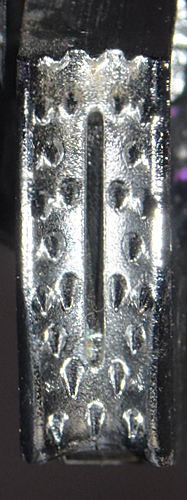 I obtained this ascender in 2017 as part of Bob Thrun’s collection, and a second from Bellingham Second Chance on eBay in 2019. On Rope 1 donated another in 2021.
I obtained this ascender in 2017 as part of Bob Thrun’s collection, and a second from Bellingham Second Chance on eBay in 2019. On Rope 1 donated another in 2021.
This version is right-handed, 104 mm. tall, 76 mm. wide, 33 mm. thick, and weighs 136 g. The rope channel is 15 mm. wide. The shell
has two small holes behind the cam that are not present on Version N.
The back of the shell is stamped with "98120A," the
Petzl logo, "CE0197," "EN567," the UIAA logo, and the Reading is Dangerous icon. The
front is stamped with a Sieg
Heil icon and "ROPEO8Ø13." The Petzl
logo is cast into the cam.
The two holes serve no practical field function that I am aware of. I assume that they were included as a manufacturing aid. Similar holes on the handled Petzls can be used to attach the Pompe pulley, but I don't see that happening with the Basic.
[ Top
| Version A
| Version B
| Version C
| Version D
| Version E
| Version F
| Version G
| Version H
| Version I
]
[ Version J
| Version K
| Version L
| Version M
| Version N
| Version O
| Version Q
| Return to E.C. Ascenders
]
Version P (B18AAA)
(#277, 2084)
Technical Details
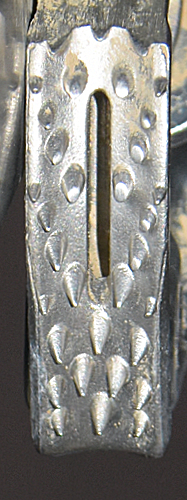 I obtained a pair of these ascenders from On Rope 1 in 2009. I acquired another in 2017 as part of Bob Thrun’s collection.
I obtained a pair of these ascenders from On Rope 1 in 2009. I acquired another in 2017 as part of Bob Thrun’s collection.
This version is right-handed, 104 mm. high, 76 mm.
wide, 33 mm. thick, and weigh 137 grams each. The rope channel is 15 mm. wide. The cam radius increases from 39 to 54 mm. over an angle of 34°, giving a 30° cam angle. The tooth pattern is (3.1.4)(1S1.2S2)^2(1S1.2.3).
The only significant difference between this version and the previous one is that this one has a small hole below the cam.
The front of the shell is stamped with "BASIC," an up=pointing arrow with "UP" inside, and a book-with-an-"i" icon. The rear is printed with "EN567: 1997 O 8Ø13, "CE0197," "Made in France," the UIAA logo, "08326FK8211," (on one, …8243 on the other), and a scanner code. The Petzl
logo is cast into the cam.
The extra hole does not seem to have a practical application. I assume that it was included as a manufacturing aid.
[ Top
| Version A
| Version B
| Version C
| Version D
| Version E
| Version F
| Version G
| Version H
| Version I
]
[ Version J
| Version K
| Version L
| Version M
| Version N
| Version O
| Version P
| Return to E.C. Ascenders
]
Version Q (B18AAA)
(#1943, 2059, 2398)
Technical Details
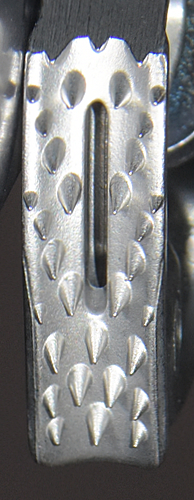 I acquired my Petzl Basic, Version Q from On Rope 1 in 2013. I acquired another in 2017 as part of Bob Thrun’s collection, a third at the NSS Convention in 2019, and a fourth from Jill Kupelion in 22. The latter was probably once used for testing, as it had remnants of a broken digital scale attached.
I acquired my Petzl Basic, Version Q from On Rope 1 in 2013. I acquired another in 2017 as part of Bob Thrun’s collection, a third at the NSS Convention in 2019, and a fourth from Jill Kupelion in 22. The latter was probably once used for testing, as it had remnants of a broken digital scale attached.
This version is 103 mm. tall, 60 mm. wide, 26 mm. thick, and weighs 87 g. The rope channel is 13 mm. wide. The shell
was completely redesigned to be considerably smaller than in previous versions. It is stamped from 3 mm. aluminum. The back is
not flat; instead, the lower part of the shell bends backward.
The upper attachment hole is 14.2 mm. in diameter. The lower attachment hole
is 16.0 mm. high and 27.9 mm. wide. There is a plastic piece above the cam pivot channel. It is attached to the shell by a small countersunk screw in the rear and the head of the cam axle in the front.
The cam is also new, and smaller than on previous models. The cam axle is only 34 mm. from the inside of the rope channel, as opposed to 46-48 mm. on earlier versions. The cam is cast from stainless steel with a web design. The cam radius increases from 24 to 45 mm. over an angle of 47°, giving a 38° cam angle. The tooth pattern is (3.4)((1S1)^2.2S2)^2(3.4.3). The injection-molded plastic cam safety
has a new shape as well, and is correspondingly smaller. Like on other versions of the Basic, the cam
safety can hook over the cam channel to hold the cam open.
The front of the shell is stamped with the
Petzl logo and an up-pointing arrow labeled "UP." The inside of the shell has a stamped book-with-an-"i" icon. The rear is printed with "Made in France," "CE0082," EN567:1997•Ø8-11mm," " EN12841:2006 B•Ø10-11mm140kg," a digital scanner code, and" the UIAA logo. The Petzl
logo is cast into the cam.
This version is considerable smaller and lighter than previous versions. This makes it somewhat more difficult to operate, particularly if I am wearing gloves.
The plastic piece above the cam axle may be unnecessary. It does not touch the cam, but it might function as a cam stop during strength tests. In the field, it might help keep mud out of the cam axle area, but it can also trap mud there.
[ Top
| Version A
| Version B
| Version C
| Version D
| Version E
| Version F
| Version G
| Version H
| Version I
]
[ Version J
| Version K
| Version L
| Version M
| Version N
| Version O
| Version P
| Version Q
]

For far more content, use a larger monitor and a full-width window.
Hundreds of cell phone users complained and asked me to for a simpler, mobile friendly site. In particular, they wanted me to limit each page to a small number of pictures and minimize my use of text. This new site provides what they asked for.




